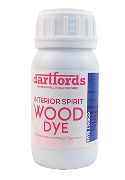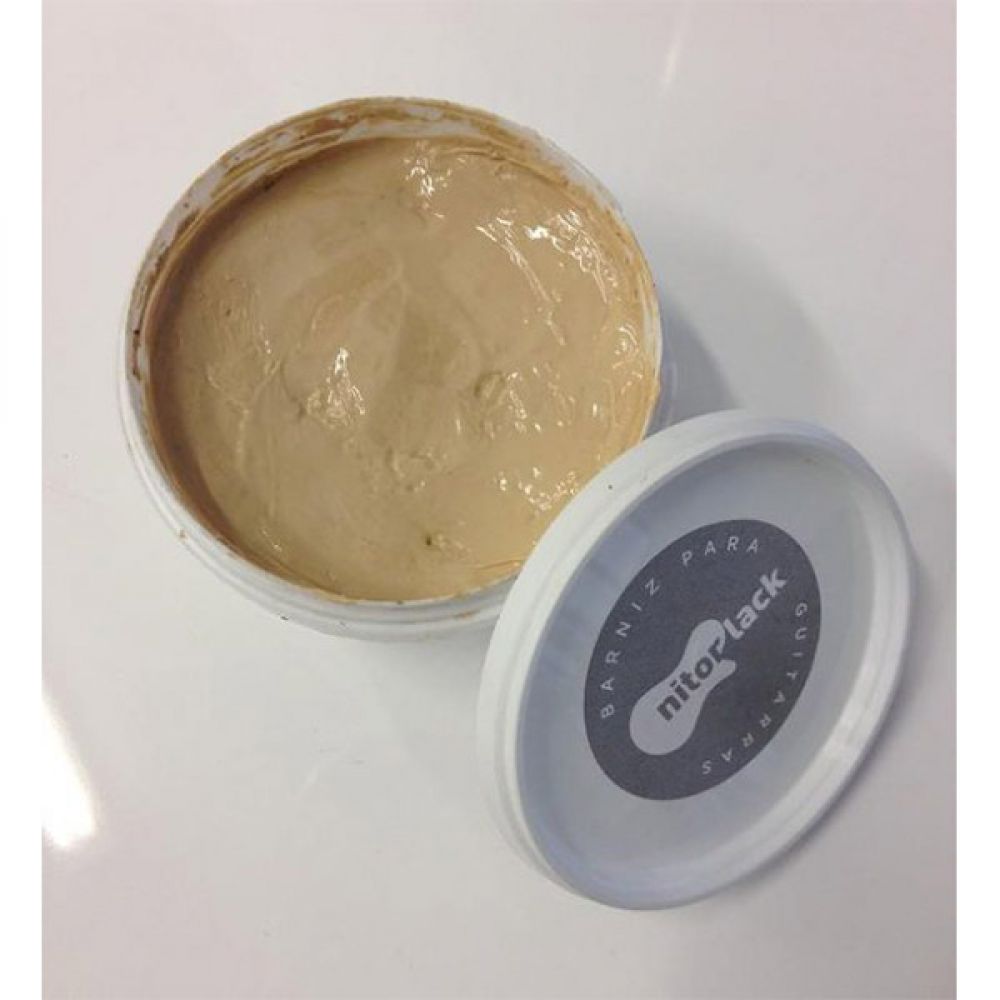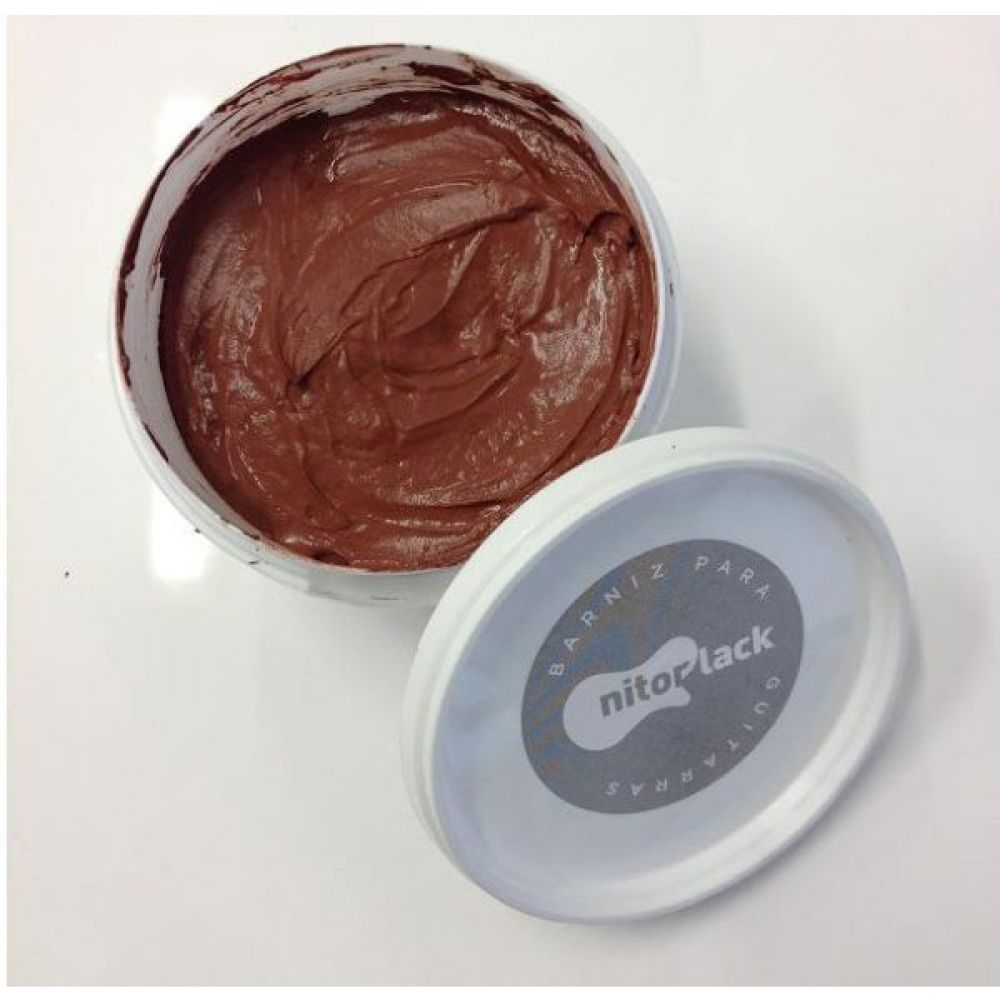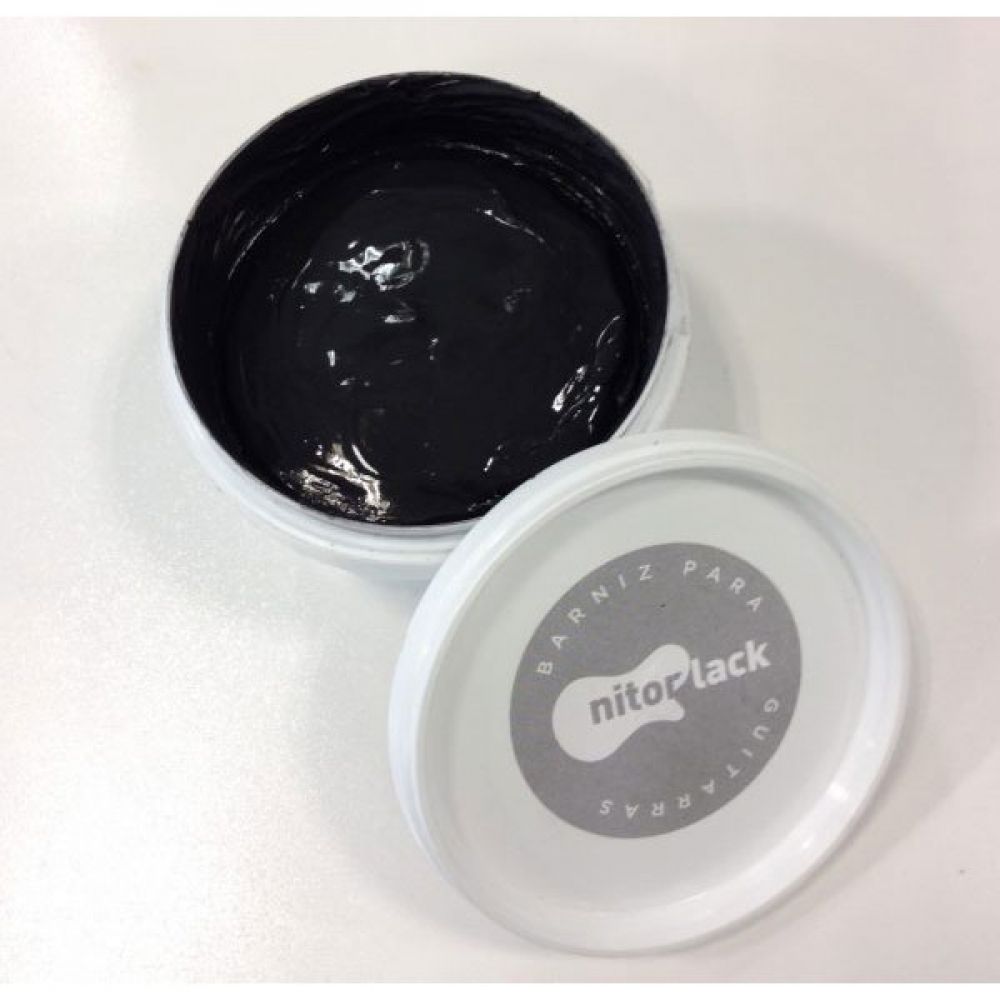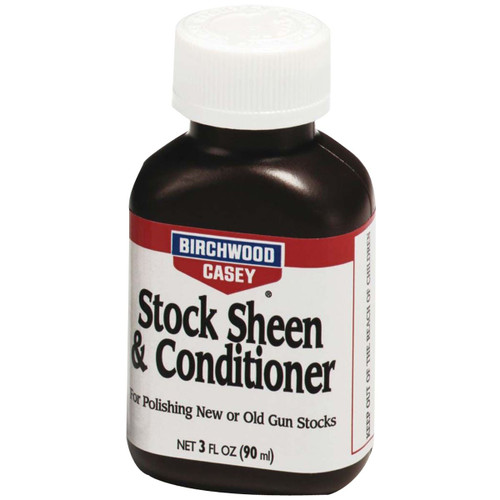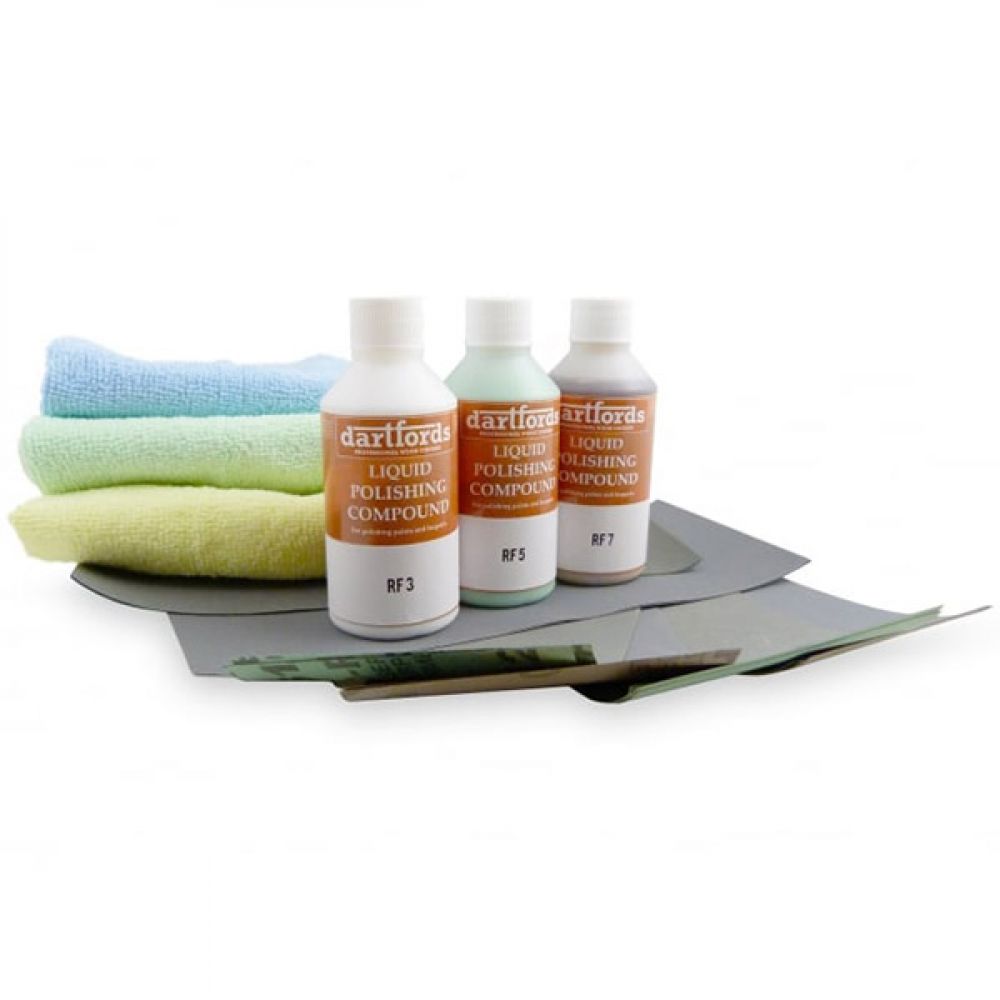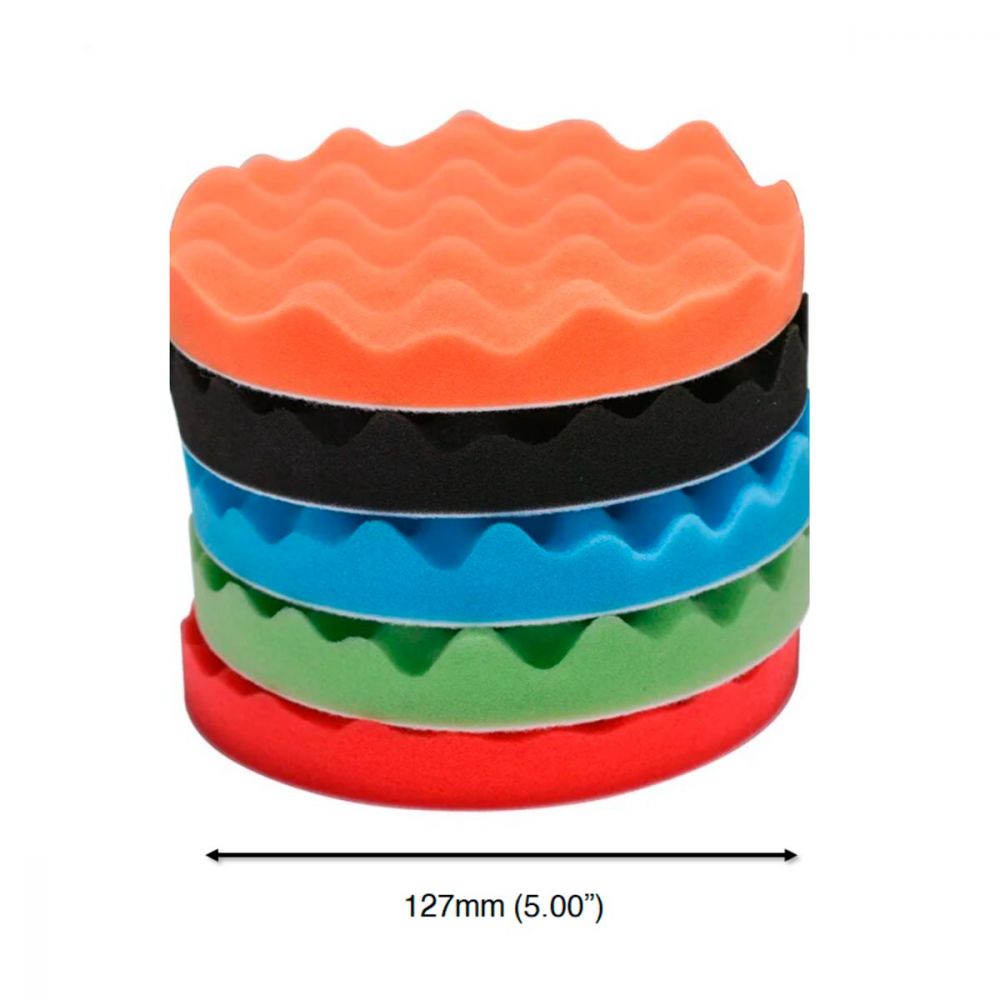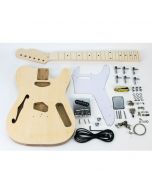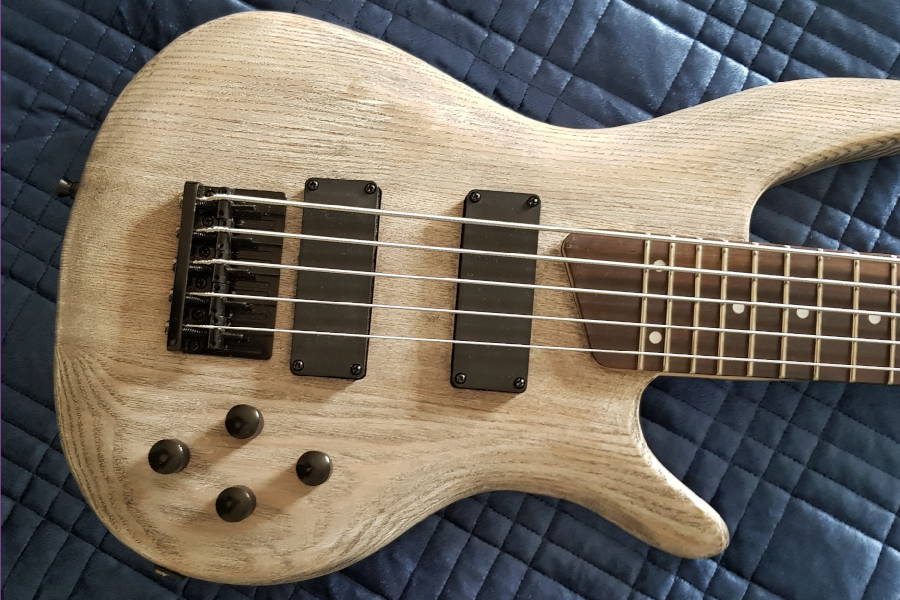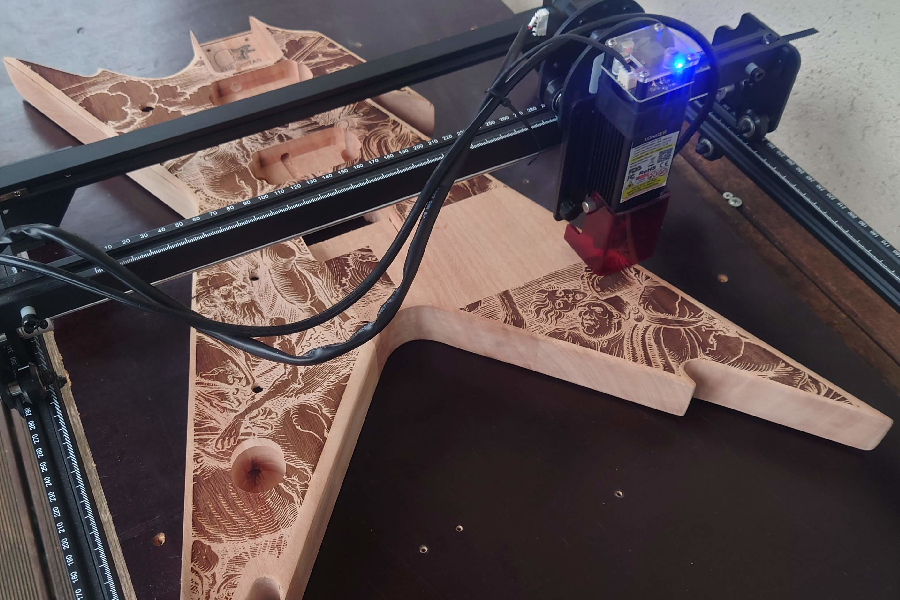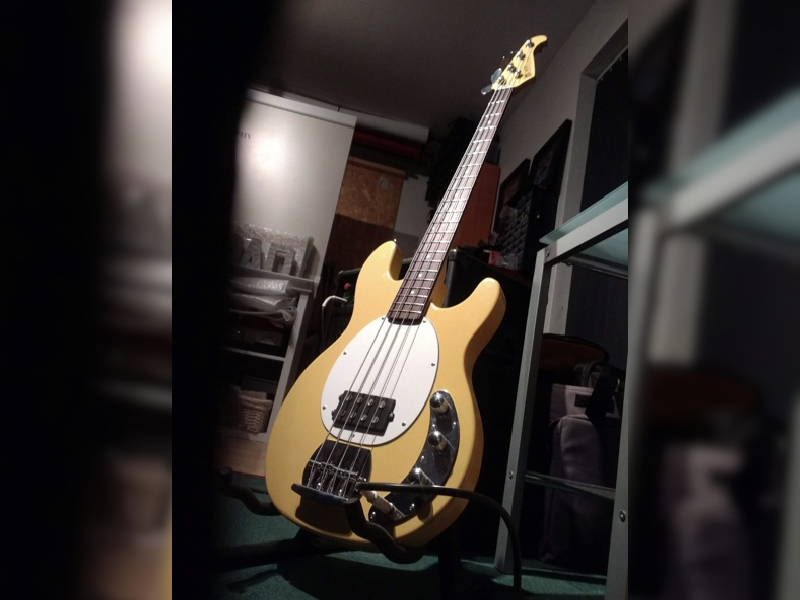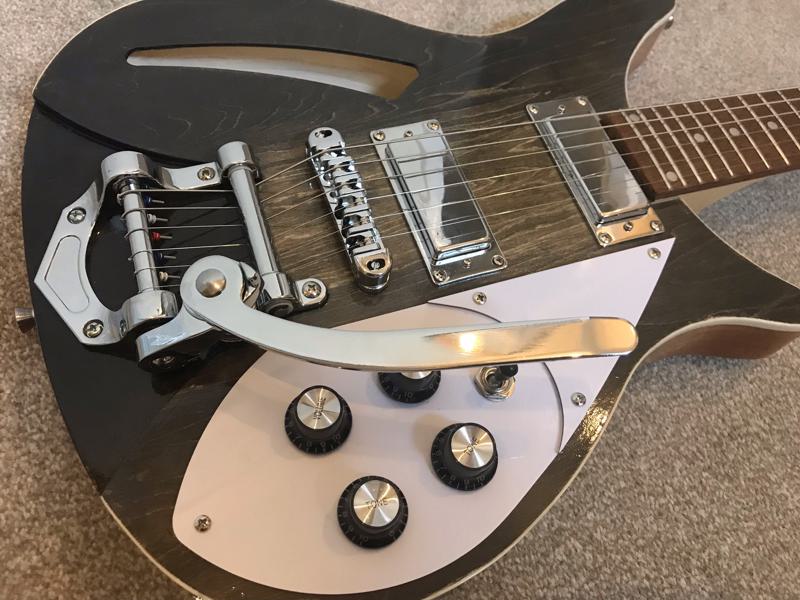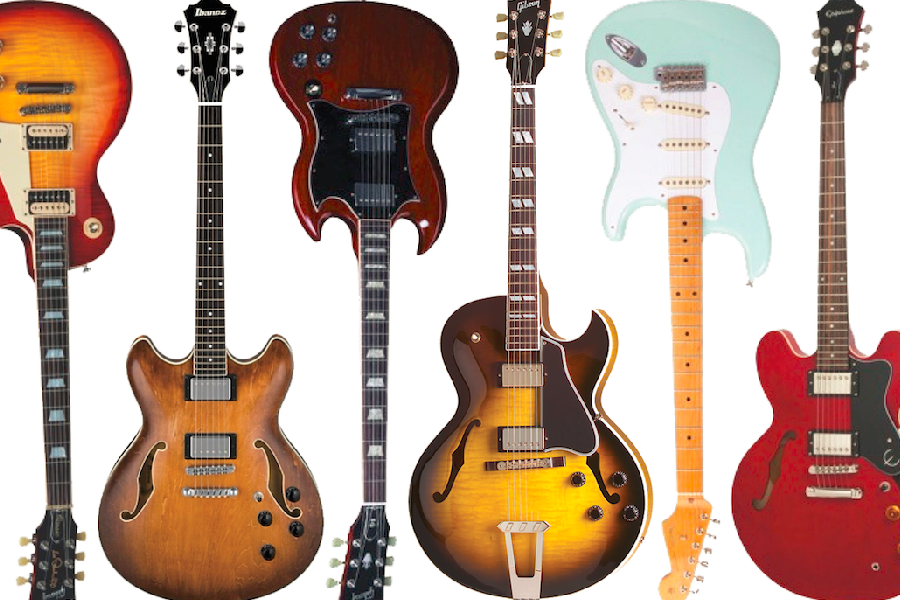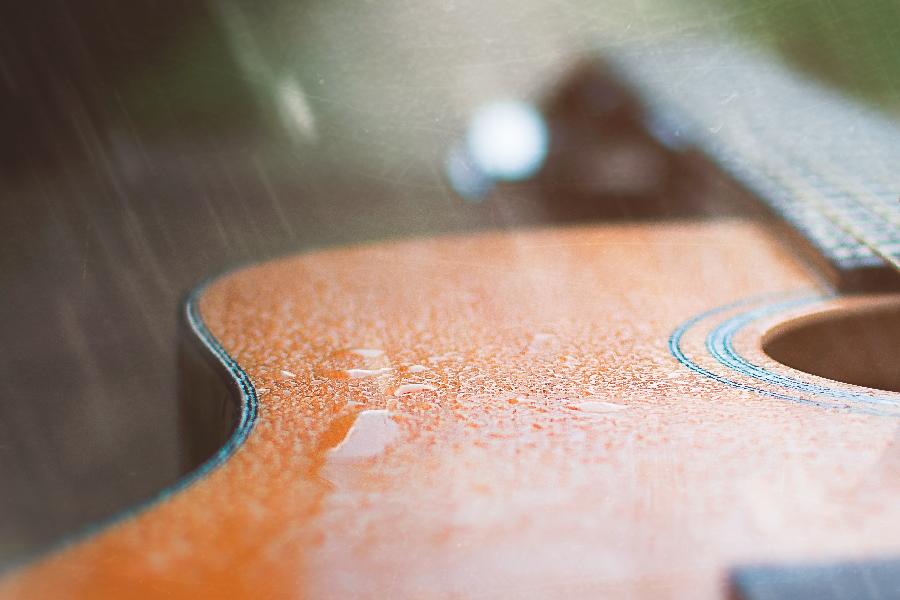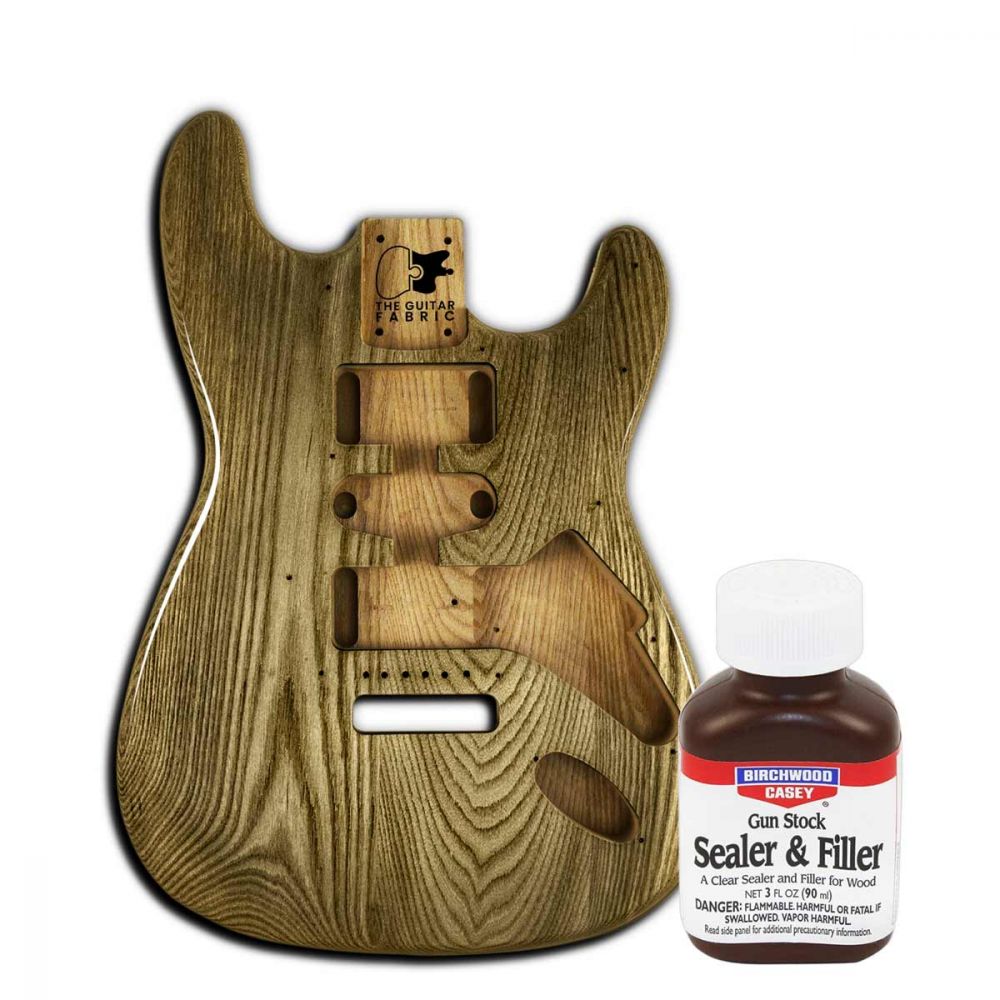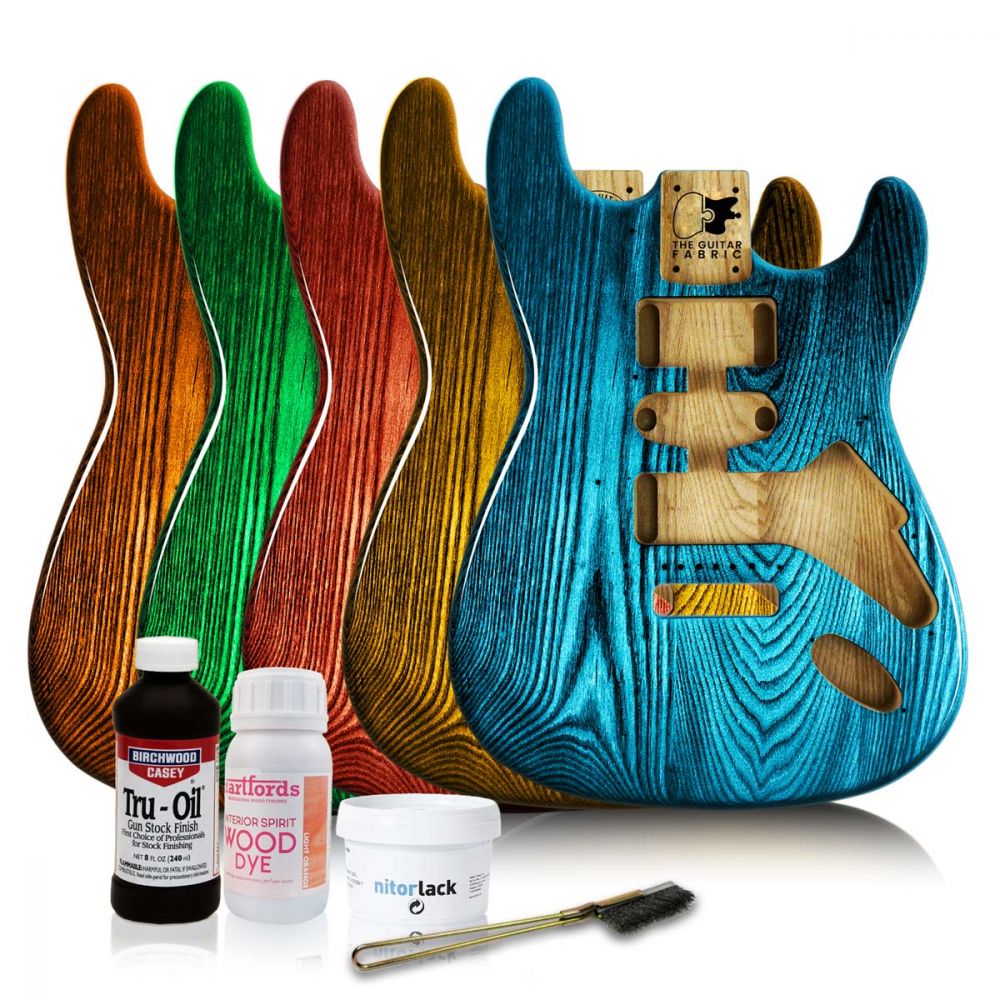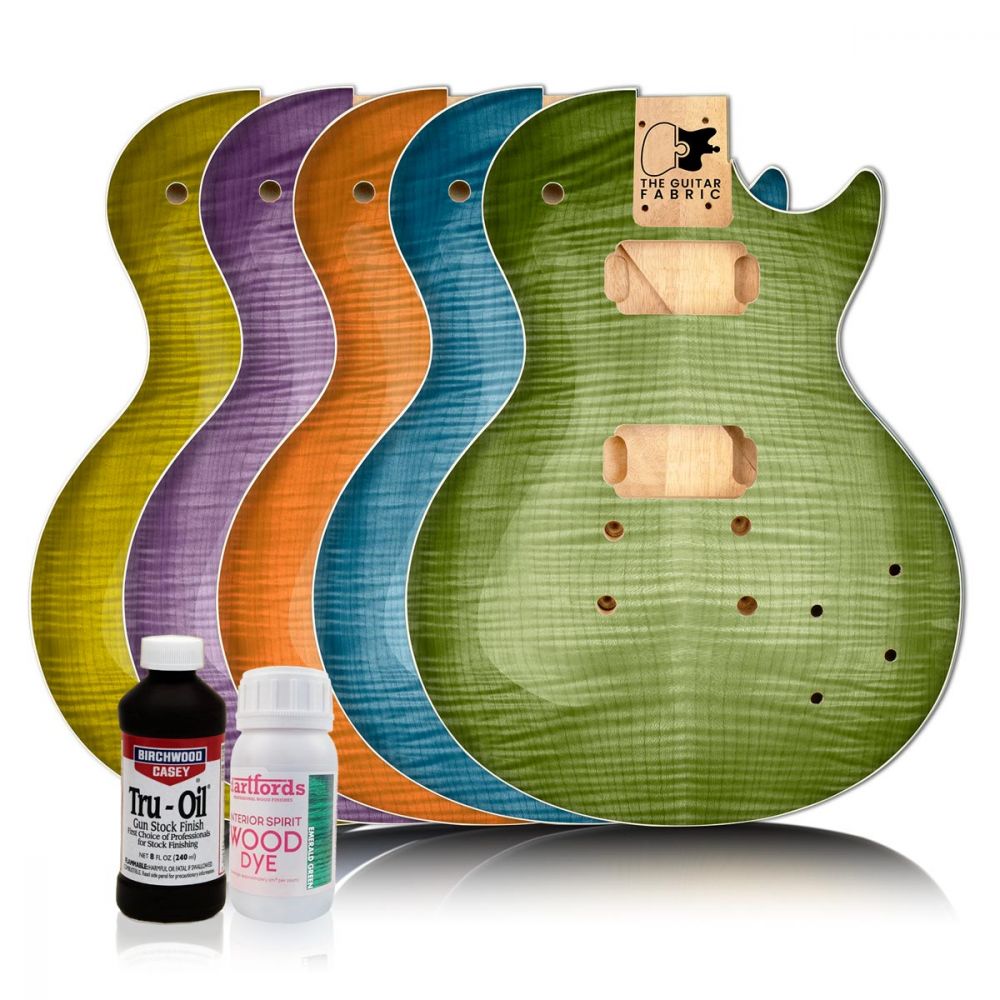GUITAR PAINT GUIDE – TRU OIL HIGHLIGHT VENEER
- The Guitar Fabrik
- PAINTING USER GUIDE
- May 15, 2025 views
- 148
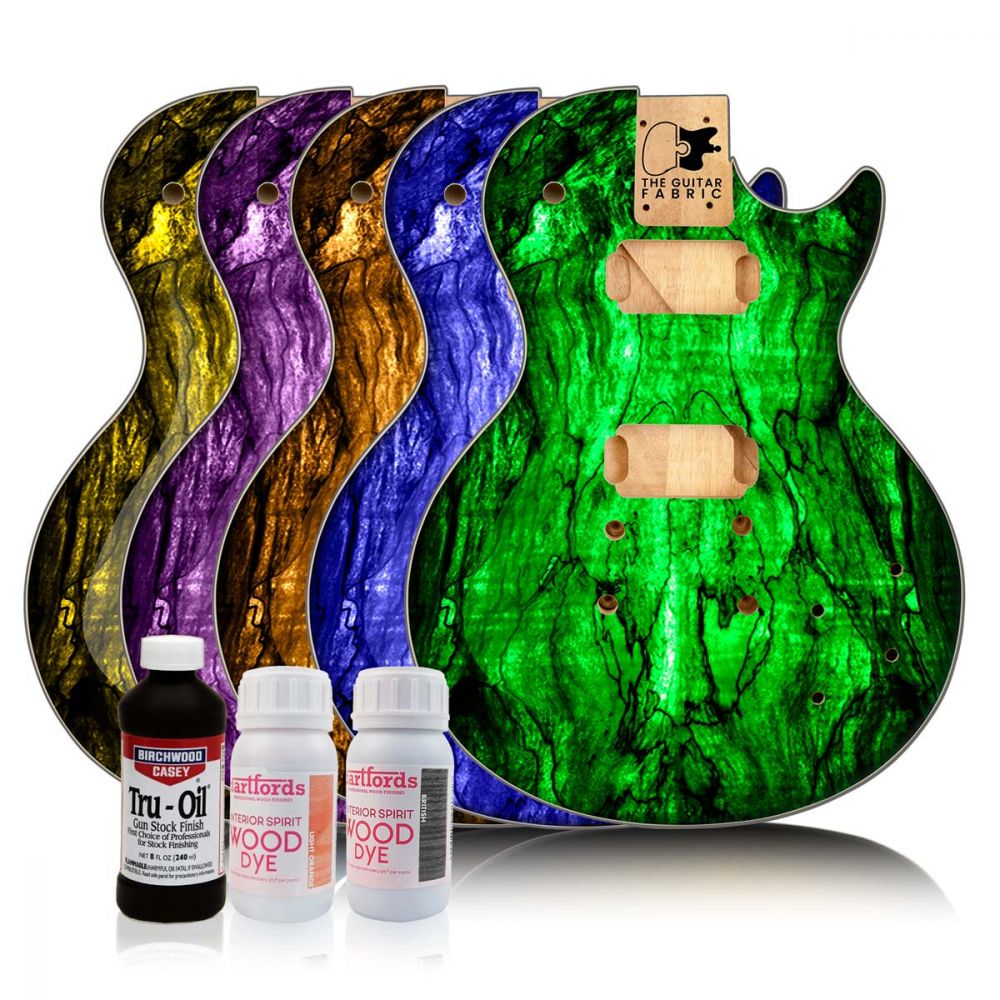
A technique adapted to thin wood placage, balancing finesse and precision to avoid saturation. Here’s the complete kit and product list for this technique:
Please take a moment to carefully review these instructions. They provide a clear overview of the process and help you avoid common mistakes. For a deeper understanding, be sure to explore the other building and painting guides available in our blog section, which offer valuable tips and techniques to enhance your project.
PREPARATION
Before Starting
• Always be very careful with your body and your sleeves. It’s easy to cause a bump, scratch, or drop of polish. Don’t rush.
• Make sure your environment is always clean. A common issue is applying stain or varnish in a dusty setting, which results in an imperfect finish.
• Don’t varnish the fingerboard unless you know this is your preference. Normally, we apply nothing or just a little lemon or mineral oil (for Rosewood or Ebony) to maintain a comfortable feel.
Useful Products Available on The Guitar Fabrik
Only the strictly necessary tools are listed here. However, you can always enhance your result using additional tools and adjustments. These require experience in lutherie and are not covered here.
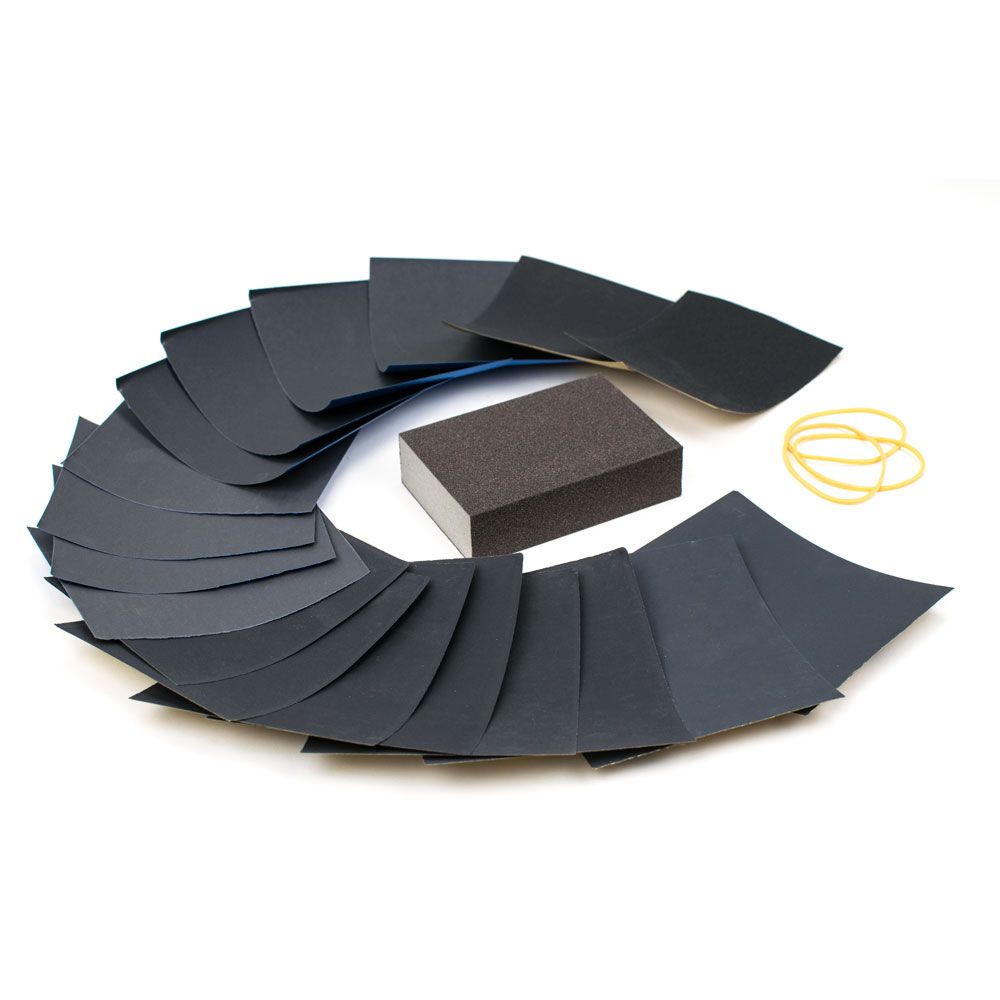 | A range of sandpapers, P240, P400, P600, P800, P1000, & P1200, for sanding and polishing. Use them throughout the finishing process, especially for initial sanding and final polishing. |
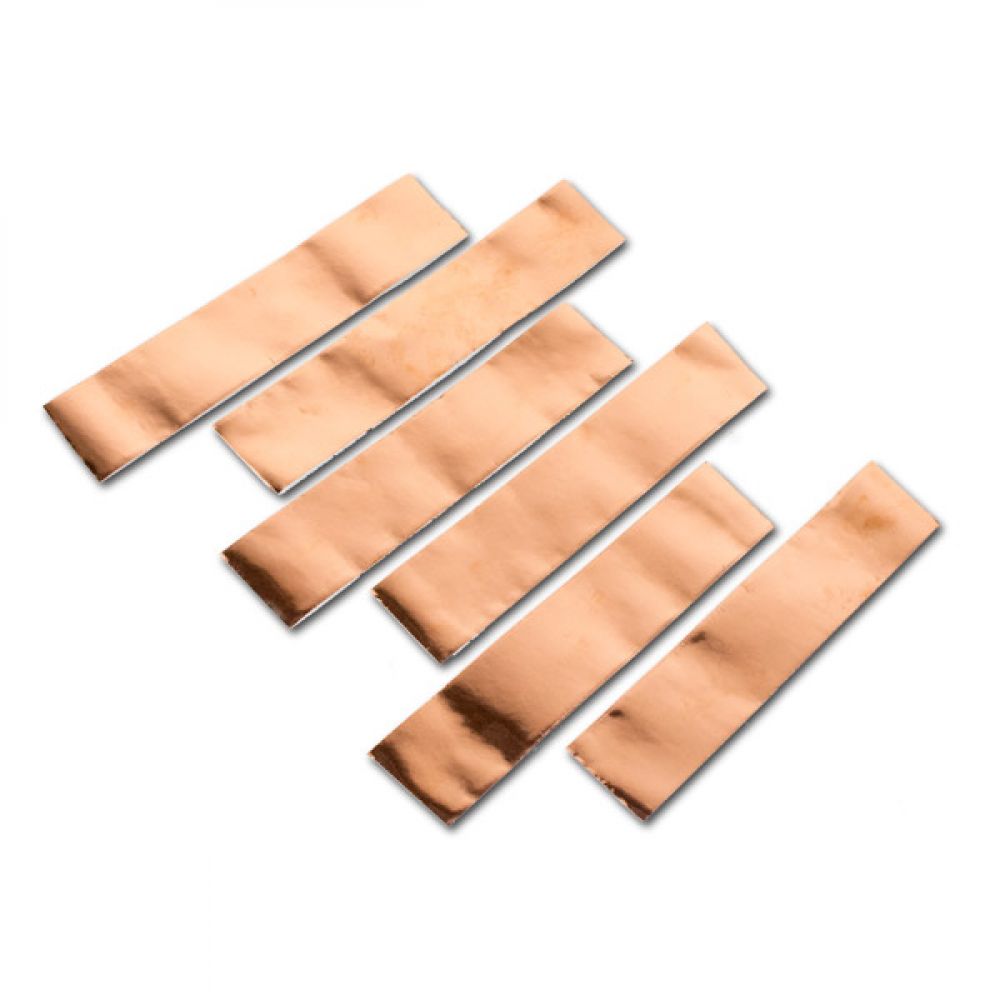 | Recommended: The adhesive copper tape will prevents electromagnetic interference from pickups and improves sound quality. |
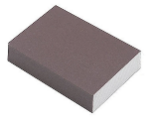 | Recommended: A 240-grit sanding block will be used in both during the early sanding and during the final polishing stages. Attach different grit papers to suit your different needs. |
 Gloves | A pair (or two) of rubber gloves to protect your hands during some finishing stages. |
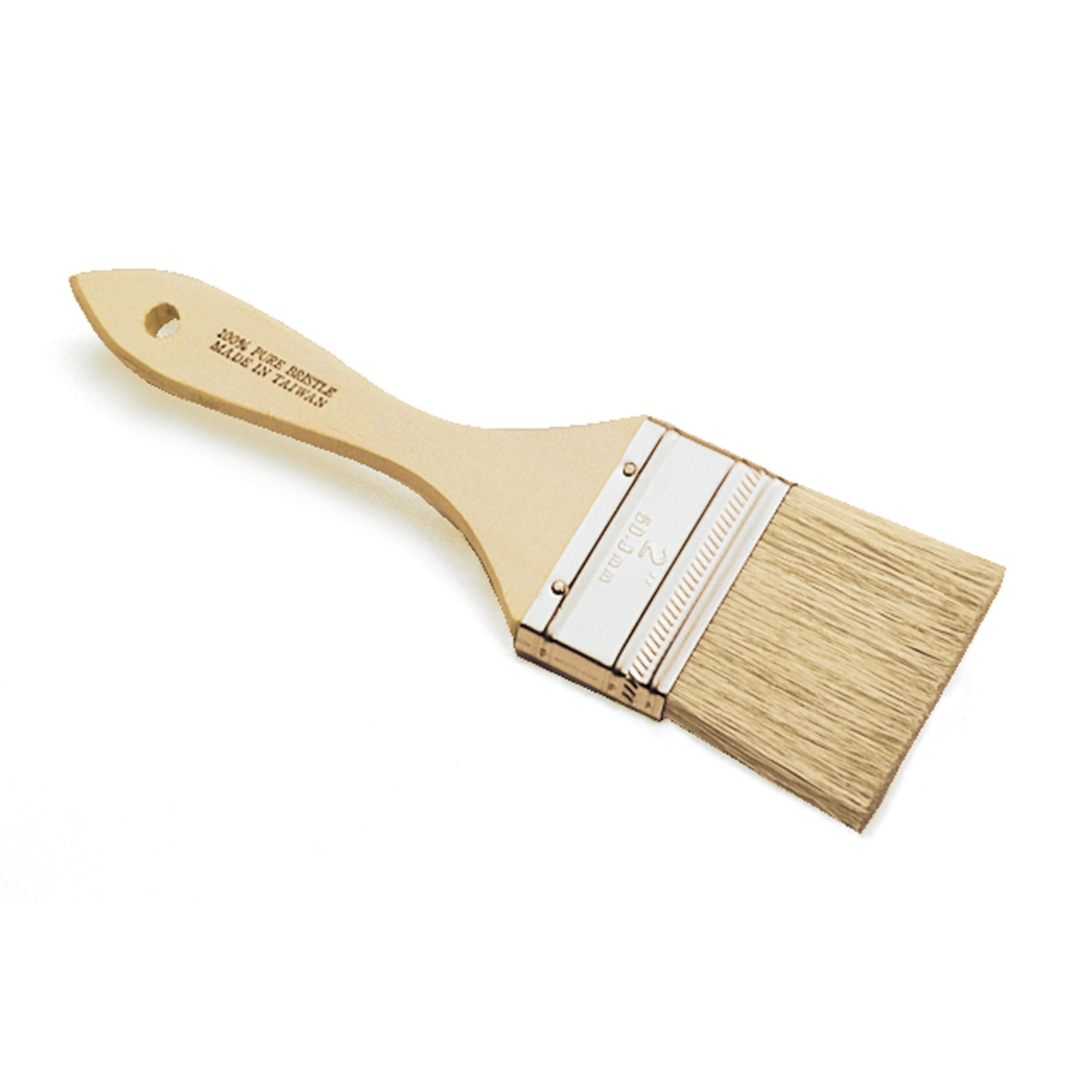 Painting Brush | Optional: A wide brush will make the applying of a grain fille, a dye or a varnish evenly, easier. |
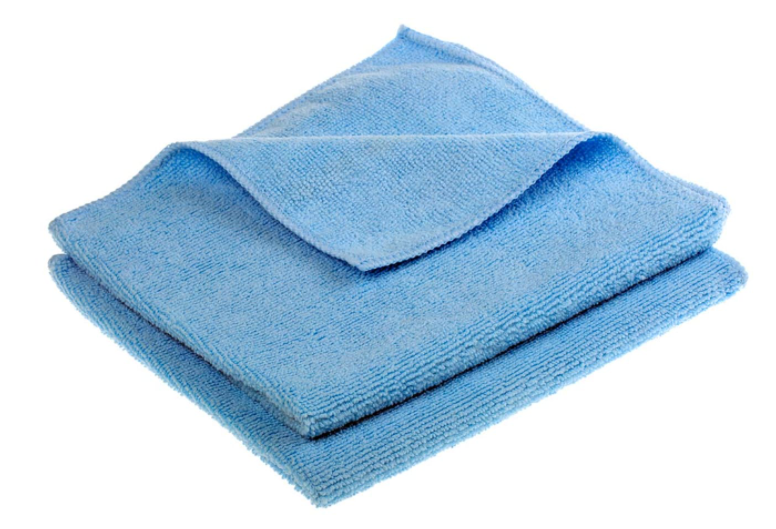 | Optional: It will be used for applying a dye, a Tru-Oil finish, a polishing product or to clean & wipe your guitar neck and body. A microfiber cloth is recommended. |
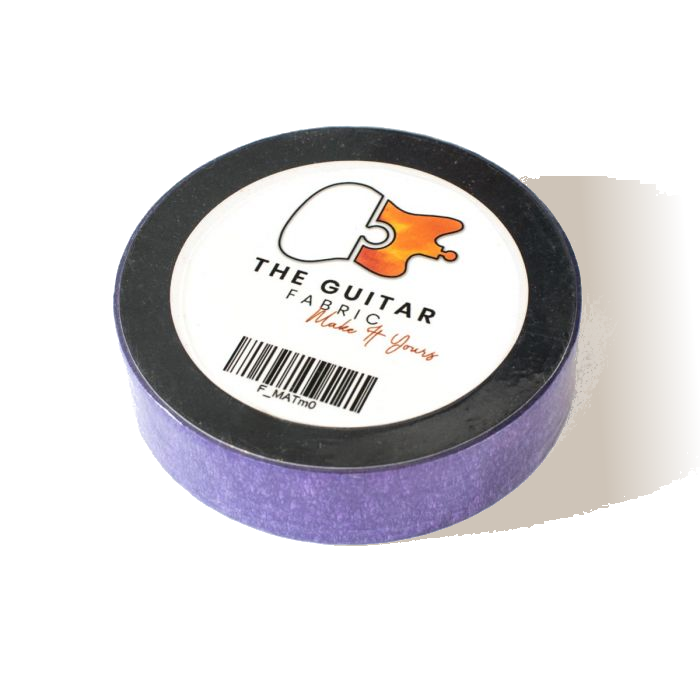 | It will be used to protect areas like the fretboard or bindings that shouldn’t be painted or sanded. |
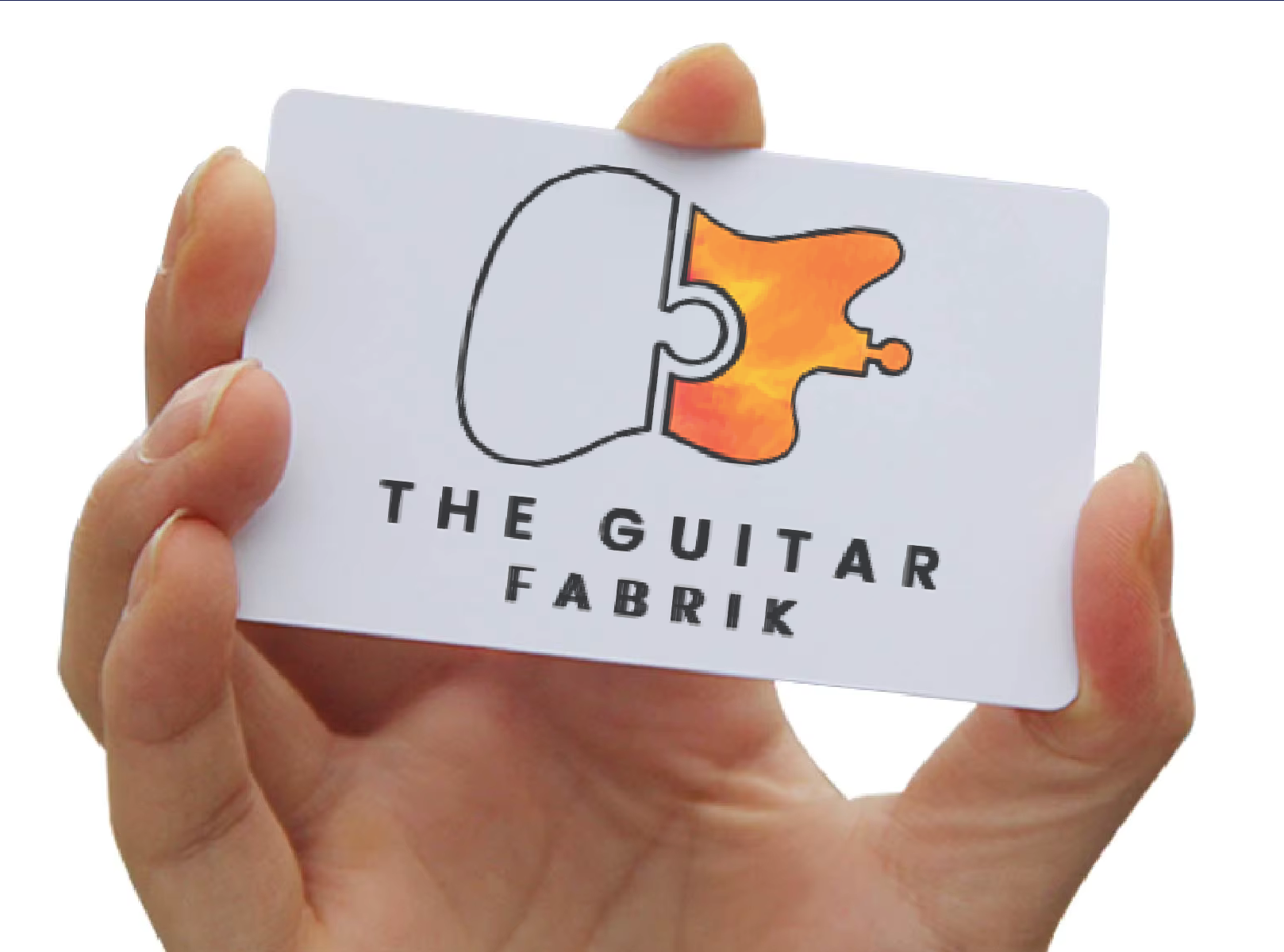 Plastic Card | Optional: Useful for smoothly and evenly applying th grain filler. |
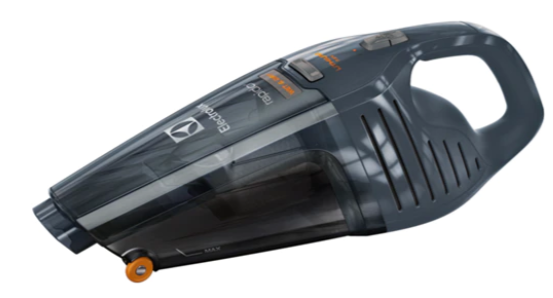 Vacuum or Air Spray | Optional: Useful during sanding to remove dust and keep the workspace clean. |
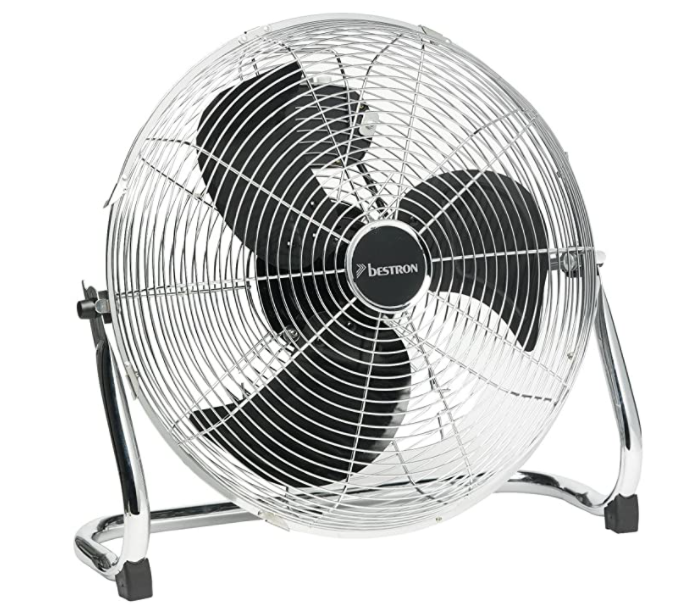 Fan | Recommended: For dry sanding during the final polishing phase. |
With the Highlight Body Top paint kit, here is the list of tools and consumables you will receive:
The grain filler will be used to colorize the grain of your wood by blending it with one of the stains you ordered but also to close the open pores of the wood. | |
| The black dye will be used to sublimate the wood table. |
The primary stain will be used to dye the body and/or the neck to color your guitar as you desire. The second selected stain will be mixed with the wood filler to exclusively colorize the wood grain using a ceruse technique. | |
The Tru-Oil is a linseed-based oil finish used to build up a durable, glossy, and protective coating that enhances the natural grain of the wood. |
OVERVIEW OF THE FINISHING STEPS
Here are the steps to follow to achieve the expected finish using your kit:
- Working environment
- Wood & grain preparation
- Grain filling application
- Staining of the wood
- Varnishing
- Polishing (optional)
The different methods and practices defined in this guide have been extensively tested. Strictly following the instructions in these instructions for use will lead to the expected results. Although it is possible to do some things differently. This method has been implemented to make it as easy as possible for the user to undertake the finishing of his guitar and to obtain a professional result as desired and at a lower cost.
WORKING ENVIRONMENT
To get a clean and professional finish on your guitar, it's essential to prepare your workspace and tools properly before starting. Here’s how to set up your painting environment.
Choose a stable indoor space:
- Work indoors in a clean, dust-free and well-ventilated room.
- Avoid outdoor areas to prevent contamination from wind, insects or humidity.
- Let the guitar wood rest in this space for 48 hours before finishing to adjust to temperature and humidity.
Prepare how you'll hold the parts:
- Hang the body and neck using screws or hooks through strap button or tuner holes.
- For spraying, fix a stick into the neck pocket to hold the body safely while working.
- For sanding and manual staining, lay parts flat on padded surfaces like foam or cushions.
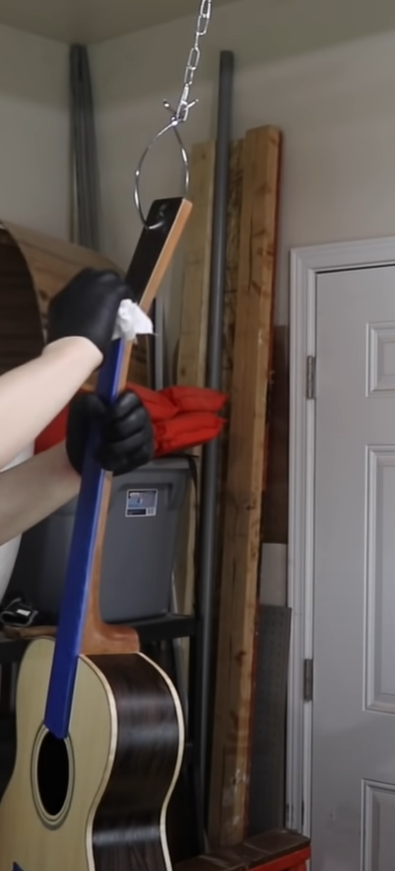
You can also fix the body to a piece of wood. This allows you to hold it in your hand when finishing with a spray or to put it in a clamp :
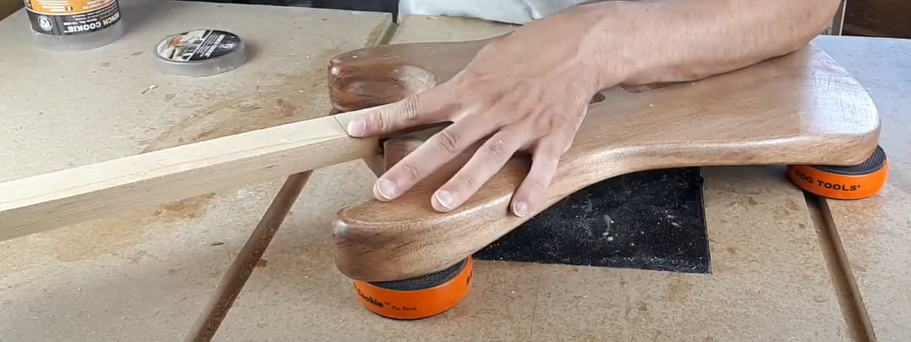
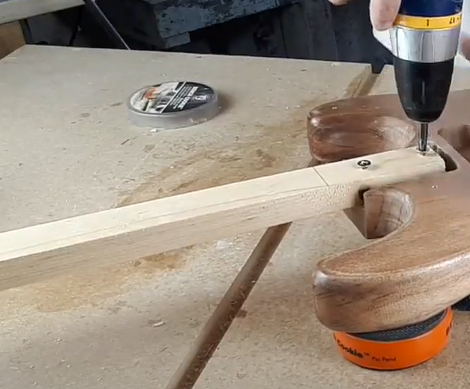
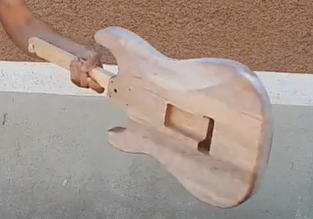
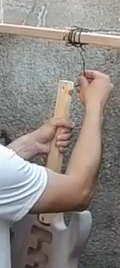

Plan your workflow:
- Decide where each step will take place: staining, spraying, drying, etc.
- Allow enough space for parts to dry between coats, without touching anything.
- Expect the full finishing process to take from one to four weeks depending on the products used.
Check your materials:
- Make sure you have all the tools and products listed in your finishing kit.
- Read through all steps and instructions before starting to avoid surprises mid-process.
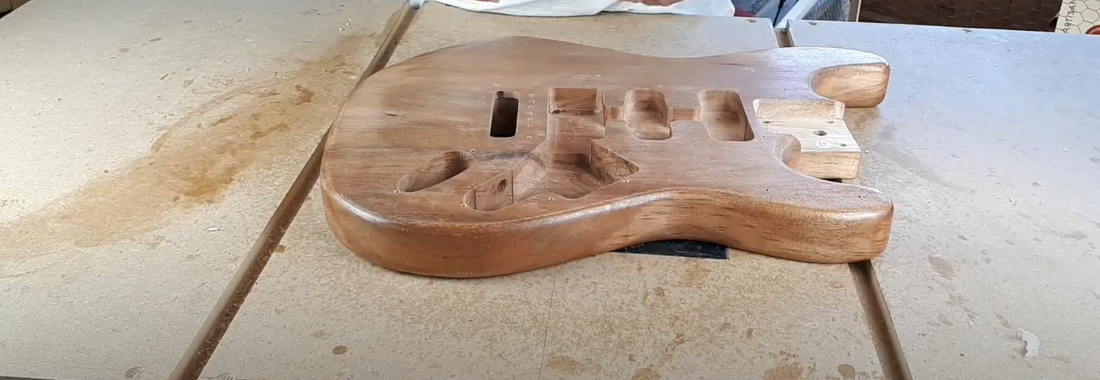
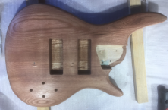
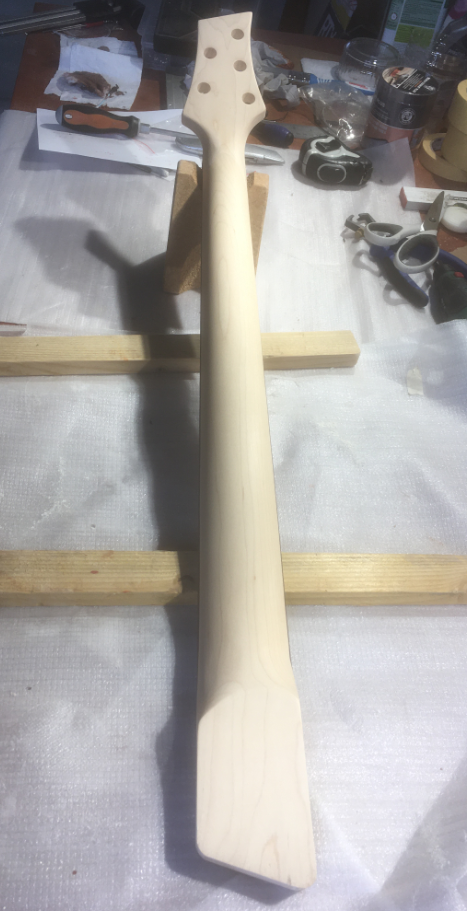
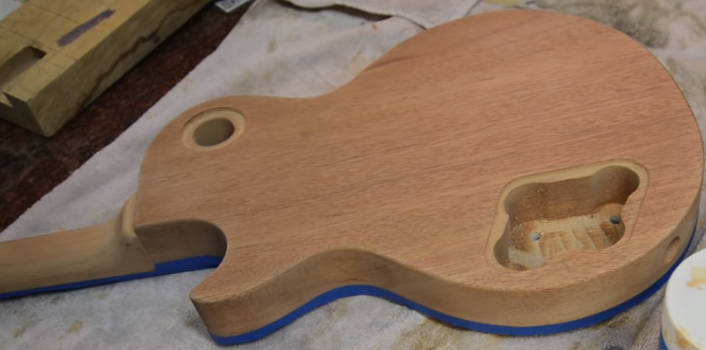
WOOD PREPARATION
Glue Stain
Before starting the finish, take a close look at your guitar body. If you notice any glue stains, remove them gently by hand-sanding with P240 to P400 grit sandpaper. Sand gradually and evenly, checking your progress regularly — the goal is to eliminate the stains while removing as little wood as possible. Also take this time to inspect the entire surface for any dents, scratches, or rough areas. Smooth them out with light sanding if necessary, as these imperfections may become more visible once the finish is applied. Finally, make sure all the contours and edges of the body are clean and well-defined, especially around routed areas, cavities, or binding. A clean surface is essential for an even grain-raising step and a flawless final result.
Raising the Grain (optional)
This step is optional but recommended for mahogany or ash when using water-based products — especially with our translucent kits. It helps achieve a smoother finish and reduces paint consumption, particularly with nitrocellulose or opaque polyurethane finishes. Skipping it won’t ruin your result, but it may slightly affect the final texture.
When water or water-based products contact bare wood, the fibers swell — this is called “grain raising”. Once dry, the surface feels rough. Since this effect is unavoidable with water-based finishes, it's best to control it before applying your stain or sealer.
To do this, dampen the wood evenly with a sponge or cloth and let it dry completely (ideally overnight, or at least 4–5 hours in warm, dry air). Then sand lightly with P240 grit paper — just enough to smooth the raised fibers without going too deep. Worn or slightly dull sandpaper works well for this purpose.
If the surface still feels rough, repeat the process with a second round of wetting and sanding, this time using finer grit like P400 for an even smoother base.
Sanding the Instrument
The purpose of sanding is to create an ideal surface for finishing and to do this we need to create a smooth surface, remove imperfections and machine marks that affect your finish. Note that your body and handle have been pre-sanded with grit P180.
First, here are some important rules to follow during the sanding step:
- Always sand in the direction of the grain (forwards and backwards with the grain) never on the side. For the sides and edge of the body it may be more difficult to sand in the direction of the grain in which case always sand in a direction that you have predefined.
- Sand first with a P240 grit, then P400 in the case of a stain. This step of smoothing wood with different grain levels is important. Each step P240 and P400 has its uses.
- Cavities that will not need to be painted since they will be covered by one of the components, pickguard pickups, etc. do not need to be sanded.
- Sand all flat faces and outlines well, and don't forget the hard-to-reach places. Then clean with a rag or with a fan to remove all dust and wood catfish.
- You should ALWAYS use a sanding block on the flat surfaces of your guitar (or a rotary sander if you have).
- When using the polishing pad or sandpaper clean it often. To do this pat and rub lightly on a rag surface to remove the dust embedded in your sandpaper. When the sandpaper becomes very worn, replace it.
- When sanding the edges of your guitar or delicate areas of the neck, remove the sanding block and simply slide the sandpaper between your fingers against the surface. It takes longer but will result in a better finish and allow you more control.
- When satisfied with your job, be sure to remove all sanding dust and grits with a vacuum, damp cloth.
Sanding by hand: This is a bit of a tedious but essential step and it is important to do it well to get a good result.
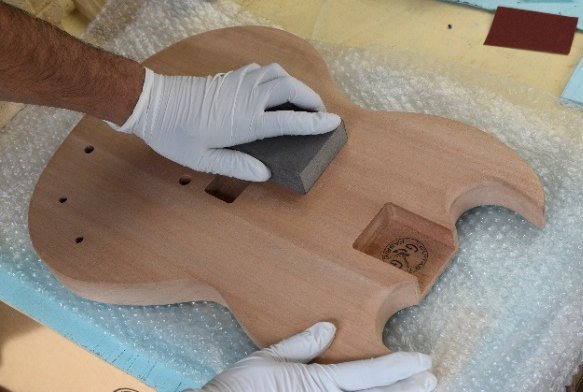
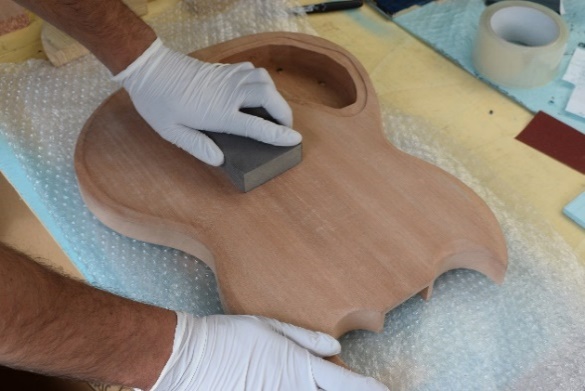
Sanding with a machine: If you have a rotary sander (excentric), don't hesitate - they'll make your life a lot easier. But take it easy!
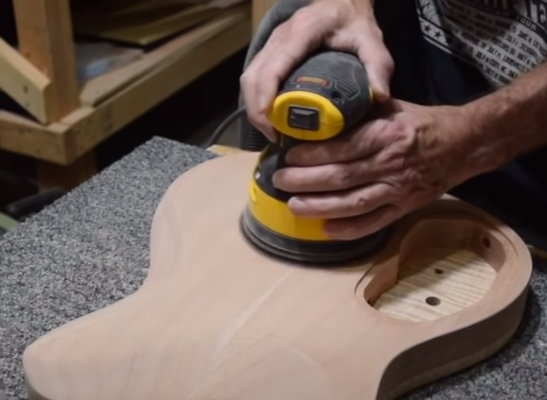
Sanding the contours: A rotary sander is no longer appropriate here, as it can easily round off or damage the delicate curves and edges of your body. Switch to hand sanding with a soft block or flexible pad to maintain control and precision. Once your contours are smooth and consistent, you're ready to move on to the next step: applying the grain filler.
Tip: For sanding guitar edges and contours, flexible tools like a foam tip, rubber eraser, cork block, or even a thermal insulation sheath wrapped in sandpaper conform easily to curves, offering better control without flattening rounded areas. Mixing these lets you adapt quickly to different shapes while staying gentle on the wood.
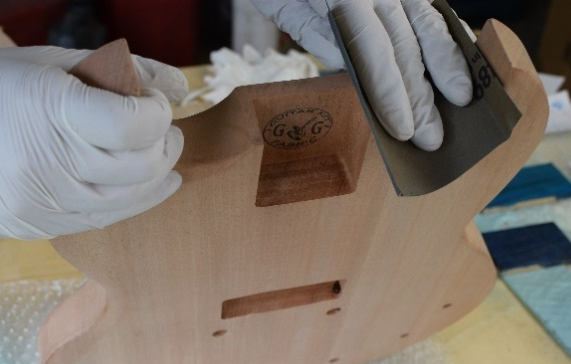
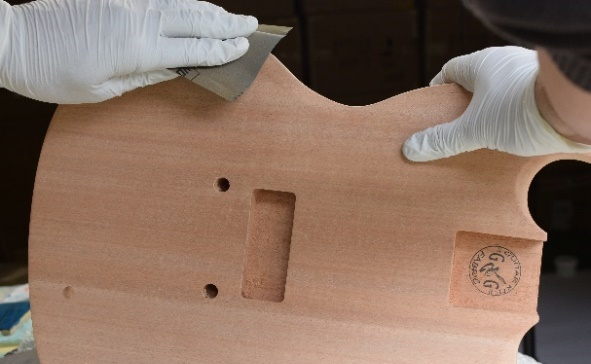
APPLYING GRAIN FILLER
General Information
Wood filler especially important for woods with open pores such as ash and mahogany. The filler will allow you:
• Use less paint or varnish because, without the pore filler, the lacquer will clog instead of the pore filler.
• Smoother and smoother finish without small pinholes
• It can also be used at the same time to pre-color your wood: black stain, mahogany, neutral wood, etc.
• It will allow a better quality finish less expensive.
Apply Wood Filler Before, After, Or Mix With dye: The guitar maker suggests either applying mixer with a wood filler or after the filler. The choice depends mostly on the intensity of shade you are looking for. You have three levers to control the intensity: dilute your dye more or less with white spirit, apply more or less layers of dye; and finally fill the pores to a greater or lesser extent (this having the pores open when tinting, which can be obtained by mixing the pore sealer with the tincture). If you want to mix your stain with the sealer, we recommend that you use a (to stay as close to the color of your stain as possible) with some tincture and white spirit.
The consistency of your final mouth pore - whether or not to mix with tincture - should be a little more runny than melted caramel and a little less than custard.
Preparation
To apply the pore filler we invite you to wear gloves although this is not harmful. We suggest that you mix our mouth pore with a little water. Let's say 10-20% lukewarm water. This will allow for easier application and avoid creating patties that would have to be sanded down painstakingly.
Application
To apply the pore sealer you can either use a cloth or a plastic card. Our preference is to use a cloth for its application and a plastic card to remove the excess while rapping.
Collect the pore sealer with your cloth and rub, pressing firmly in a circular fashion throughout your body (and handle, if you have decided to sublimate and fill the grain of your sleeve). The idea is indeed to fill the pores and you can imagine that you have to push the sealer into the pores, the interstices of the wood.
Surface, wait 2-3min, no more, then scrape off the excess pore sealer from the wood surface with a plastic card provided. The goal is for the mouth to only pore in the interstices and thus maintain a smooth surface. It is preferable to grate perpendicular to the direction of the grain so as not to remove the filler lodged in the interstices of the veining. Then do the other surfaces in the same way. In more difficult-to-scrape areas you can use a clean cloth in place of a plastic card to remove excess sealer. Remember to treat the edges as well. These areas are easy to overlook.
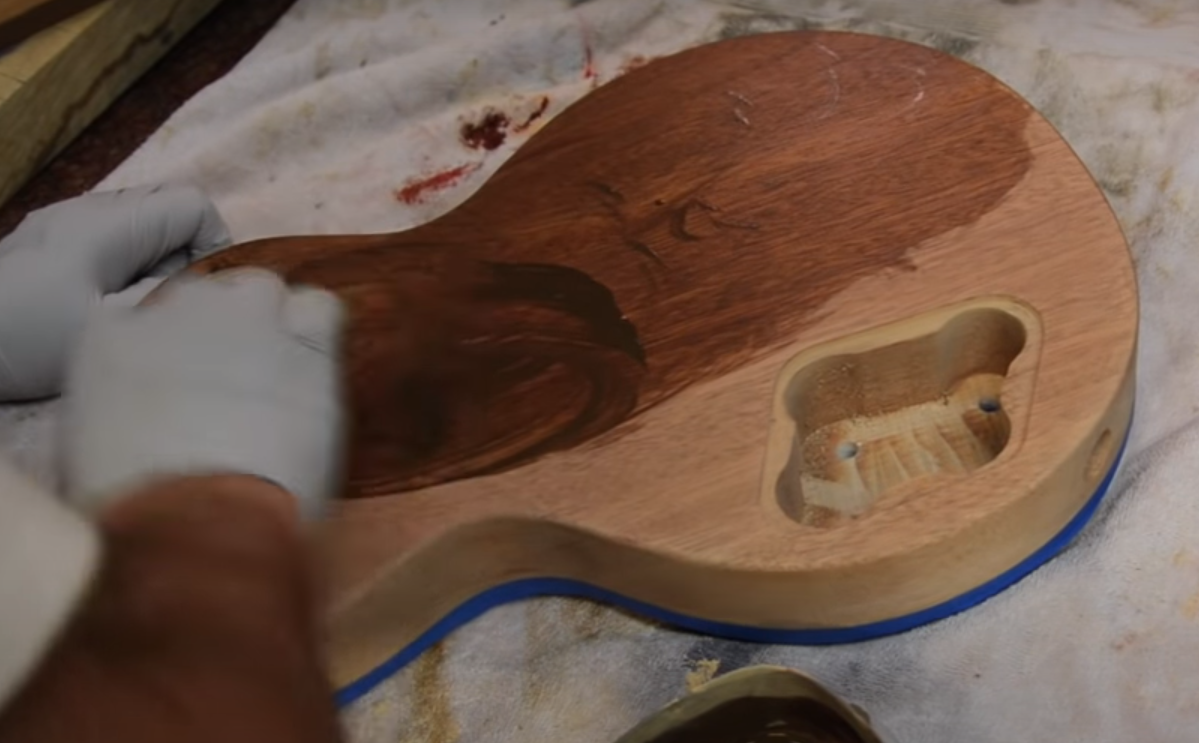
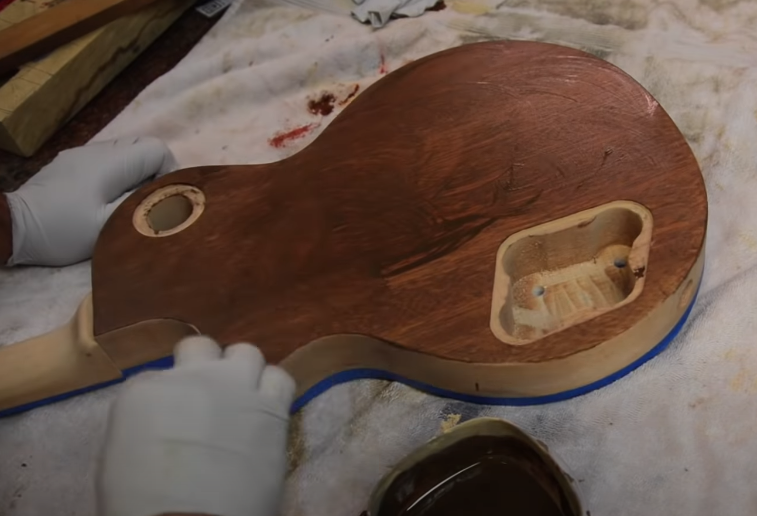
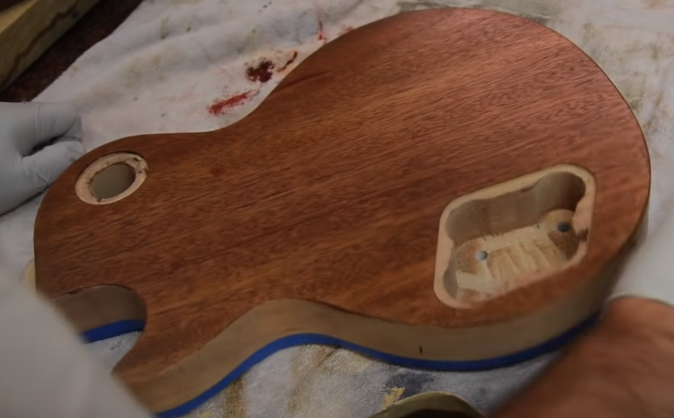
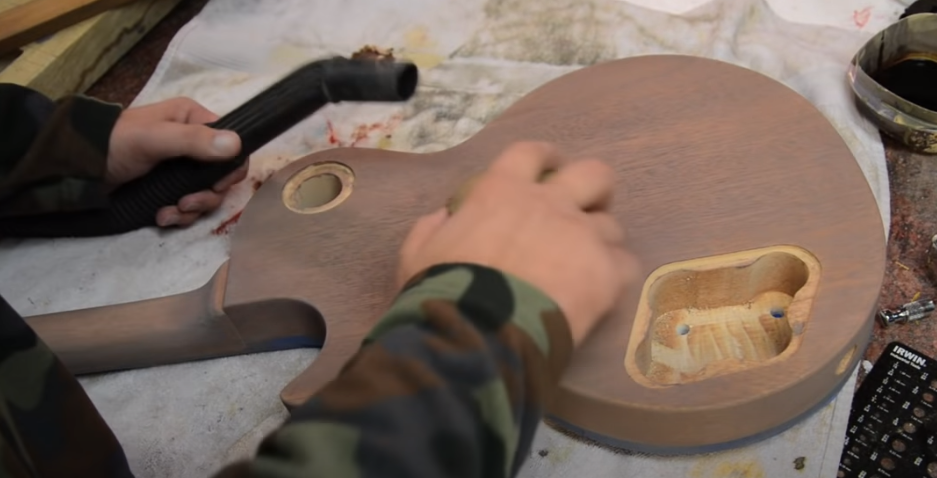
Once all the surfaces are done, let dry for 1 hour then sand with P400 grit sandpaper as defined in the previous section above. Be careful not to sand too much. You don't want to remove the sealer you just applied. Sand the edges carefully as well.
Finally, inspect your work. You can easily see if all of the pores are filled by looking at the surface at an angle, against bright light radiating obliquely toward the surface. If you missed any areas, you can always reapply wood filler.
Manage the bindings: The bindings should have been carefully masked off before you began painting or finishing. Once the rest of the guitar is complete, you can remove the masking and inspect the bindings. If any finish has bled over the edges, use a sharp blade or fine polishing tools to clean them up gently. This final step adds a professional touch, highlighting the clean lines and craftsmanship of your instrument.
BLACK PRE-STAINING
Before proceeding with the main staining process, applying a black stain as a base layer helps to emphasize the natural details of the table. This preliminary step enhances the wood grain by creating contrast, making the final color more vibrant and visually striking. By adjusting the intensity of the black stain and carefully sanding afterward, you can achieve a more refined and textured look, ensuring that the wood’s natural beauty stands out before applying the primary stain.
APPLICATION
To apply the black stain to the table, soak a cloth with your stain solution and apply it to your wood in a circular motion. For black stain we even suggest diluting with 80% white spirit. Apply a layer of stain to the entire body table.
Let it dry for half a day. In principle you should see differences in intensity on your table, darker or darker areas.
Here is an example of two cases, a black dye diluted in the proportions 20% dye / 80% white spirit (left) and an undiluted black dye (right) :
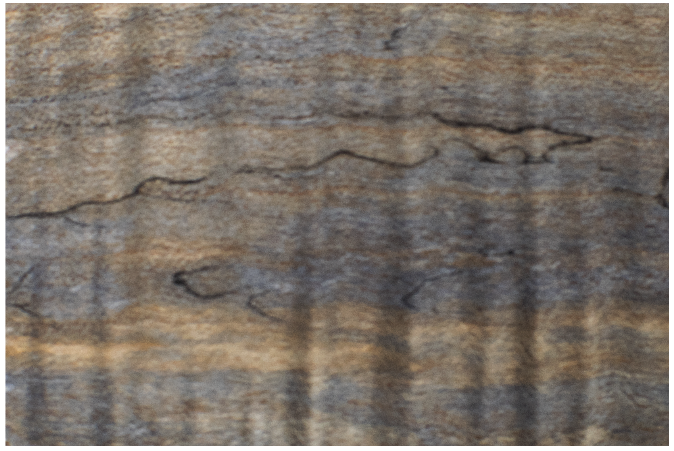
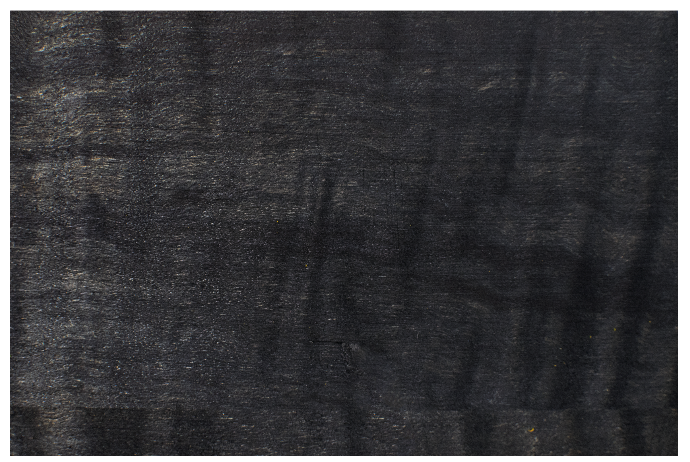
Once your wood is dry, you should now lightly sand it with P600 grit. This will allow you to find the almost original colour of your wood (slightly darker) and to create more contrast. Below is the result obtained after sanding for 4 cases:
- A coat of yellow stain applied without dilution and without using black stain beforehand.
- A coat of yellow stain applied without dilution with a light black stain beforehand. This corresponds to the case of black stain diluted to 20/80% in the same way as in the previous image, which has been very lightly sanded.
- A coat of yellow stain applied without dilution with a medium black stain beforehand.
- A coat of yellow stain applied without dilution with a deep black stain beforehand. This corresponds to the case of the unthinned black stain shown in the previous image, but which has been sanded.
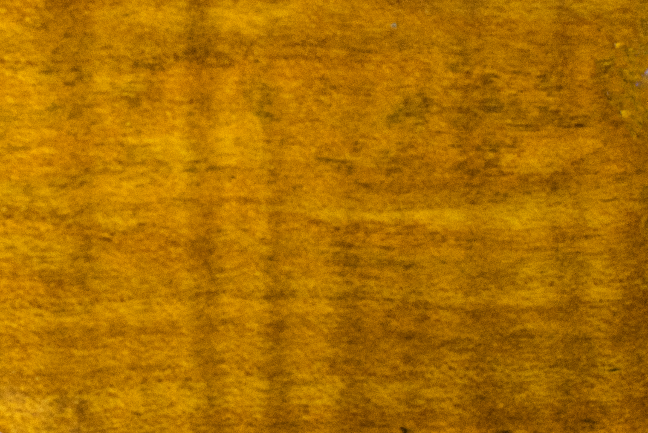
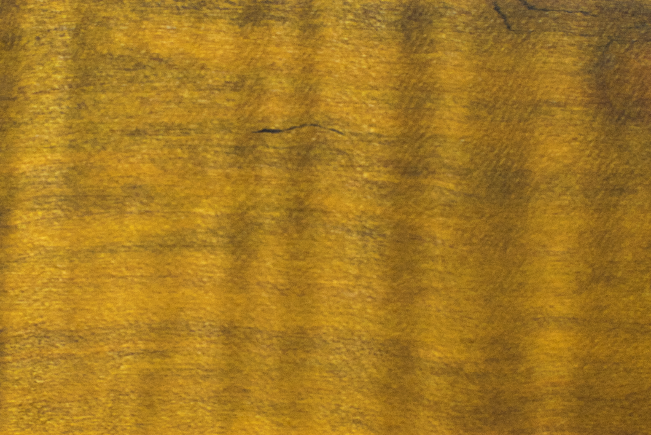
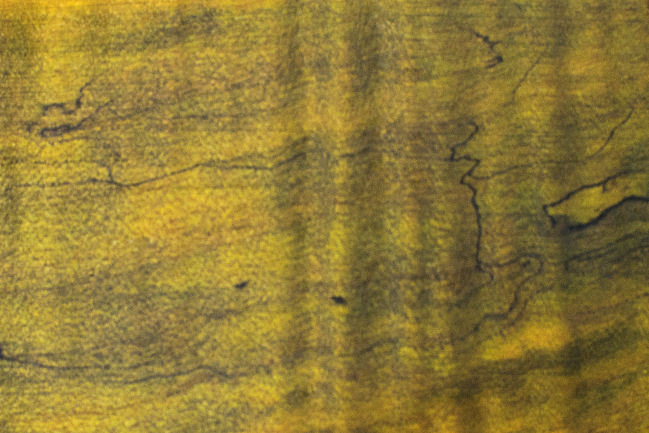
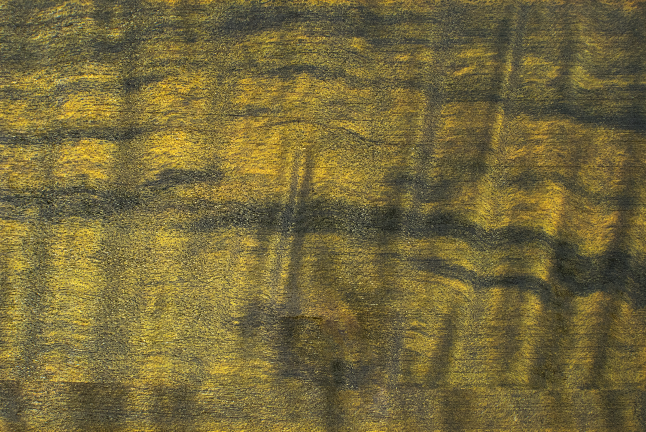
Depending on the desired result you can then re-dye a little more to increase the contrast or sand a little more to lighten the table. But always keep in mind that the sand...
DYE THE WOOD
General Information
- Applying the stain is the easiest step among the different finishing steps and is also the most enjoyable as it will make your guitar kit look beautiful.
- The main difficulty with dyeing is anticipating the final results. Indeed, depending on the wood, the stain concentration and the varnish, the end result will be different. As a general rule, you can use the color rules (yellow with blue will make green, etc.). So, at a high level, a mahogany which as a red tint applies a blue tint will create a purple coloration. Your best bet will be to use a sample of wood sold on our website to test the finish upstream and get the finish you are really looking for.
- We suggest going step by step. First stain with a strong dilution like 40% white spirit (again do not mix with water if you are using a water-based varnish). From the results you get, you can then increase the coloring by adding more coloring product. You can even use pure tincture as well as multiple layers to further increase the intensity.
- Do not apply too much dye at once. It is not good that the wood is too wet. Be especially careful with a veneer.
- Unless you want to readjust your color and tint concentration, there is no need to sand between coats of stain.
- To control the intensity of the stain, you can apply extra coats of stain to increase the intensity or sand lightly to reduce the intensity (but try to avoid sanding).
Apply a water-based stain with a water-based varnish: Please note, water-based stains are not compatible with our water-based varnish. Indeed they will react together and mix. Use an alcohol-based stain such as our stains sold on our website or included in your finishing kit.
Pre-Treatment (to Increase the intensity of your Dye)
Sand up to P600: We invite you to sand with P600 grit after a first stain if you are looking for intense coloring. Indeed, the stain will be able to penetrate the wood better if the wood has previously been sanded less finely. You can then apply a second stain. Otherwise you can sand with P600 grit and then apply your first stain.
Lift the pores of the wood before staining: Although optional and only for mahogany or ash, lifting the grain of the woods you wish to stain is useful if you wish to increase the intensity of the stain. This is because woods will accept more stains if they lift the grain before staining. To do this, wet a clean cloth with water and wipe the wood with it. While you shouldn't flood the surface, don't be afraid to get it wet either. The water will penetrate the wood and cause the grain to rise and open. Let the wood dry completely, overnight, or wait 6 to 8 hours if your working environment is at room temperature and humidity. The grain should now pick up and your surface is now ready to accept more stains. Do this process only once. Do not use this process on veneer.
Mix with wood filler: if using wood filler as explained in the filler section. This will significantly increase the intensity of the dye.
Preparation
Pour a small amount of your dye into a clean container, then add a few drops of white spirit to dilute it. As a starting point, we recommend a 60% dye to 40% white spirit ratio for the first coat. This mixture offers a good balance between color intensity and control. However, feel free to adjust the dilution depending on how deep or subtle you want the color to appear — it all comes down to your desired finish!
Application
To apply the stain, soak a rag in your stain solution and apply it to your wood in a circular motion. Do not moisten your wood too much. Then leave to dry for 1 hour. Check your results and based on your satisfaction, adjust with an additional coat of dye with an appropriate adjusted concentration.
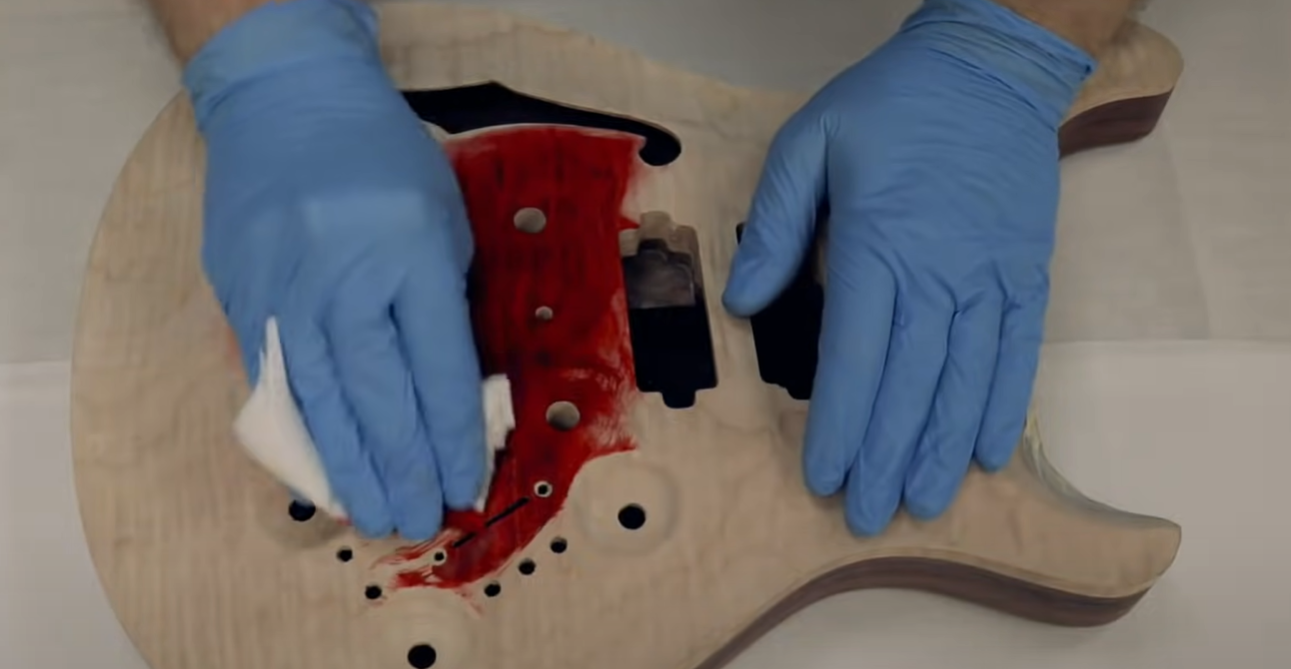
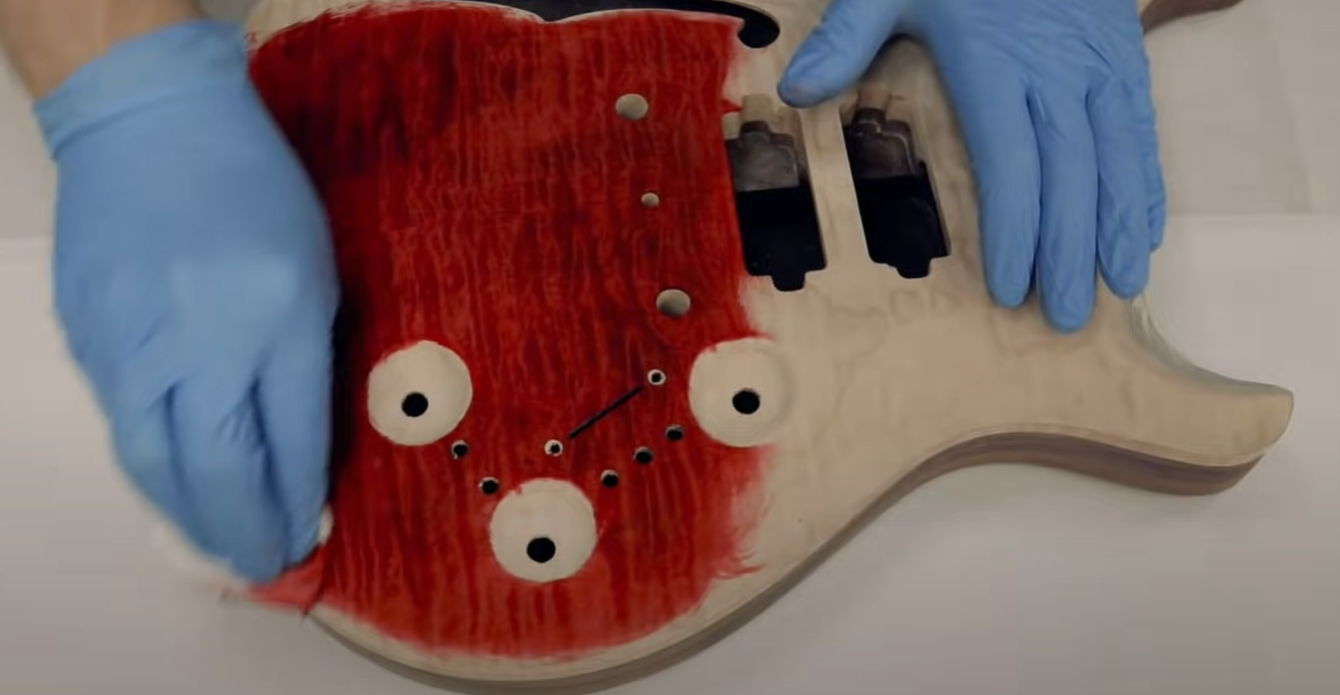
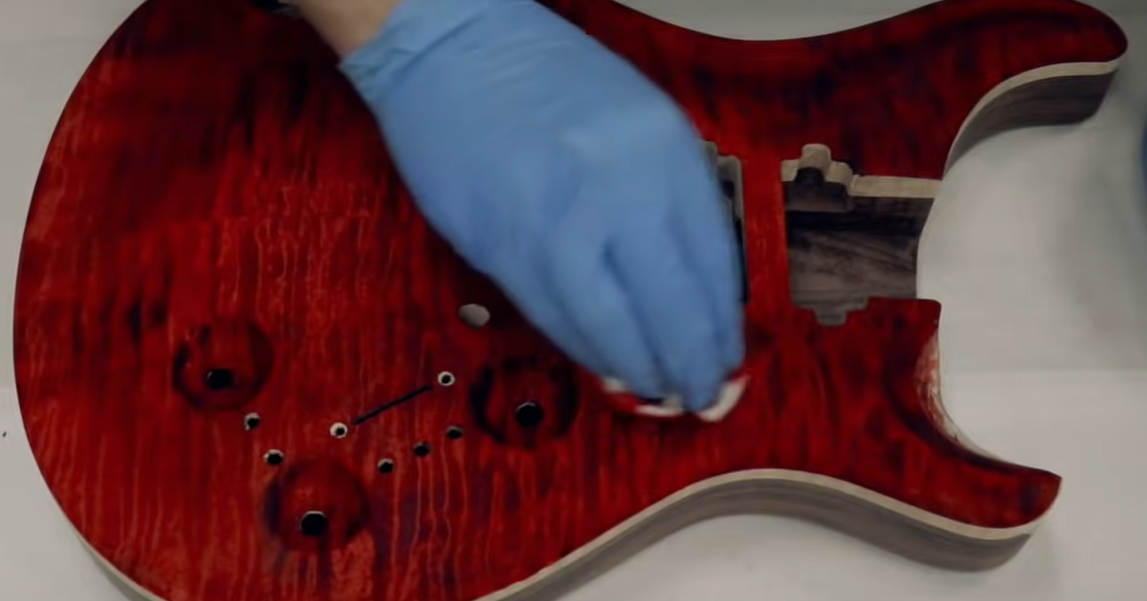
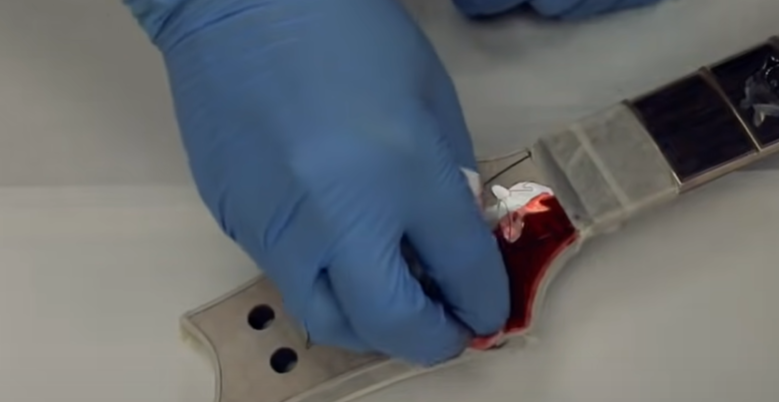
Once satisfied, wait 2 days before embarking on the rest of your finish!
TRU-OIL VARNISHING
General Information
Although store-bought electric guitars are finished in polyurethane, we have chosen to propose a solution using . The reason is that it is easier to apply and almost non-toxic and provides better enhancement of the wood for translucent finishing. Please keep in mind the few comments below.
- Before starting the varnishing step, make sure your wood has been sanded with P800.
- It is important to apply thin coats as much as possible to achieve a smooth finish.
- Quite a lot of coats will be needed so I will say it is the step you might spend the most time on.
- Each time you add a coat it will adjust the coloration of the wood, I will say darker with a light tint of amber.
- Inspect your wood well after each coat to make sure it's all good.
- Remember that compared to other finishing products dries quickly.
- Use gloves.
Preparation
Before opening, we invite you to shake your bottle to make sure it is homogeneous. Make sure the guitar body is clean, dry, and free of dust or oils. Position the instrument on a stable, well-ventilated, and dust-free surface, as described in Section III. It's essential that the wood is properly sanded and, if desired, grain-filled. Take a moment to inspect the surface for any imperfections—once the finish is applied, they’ll become more visible. When everything is ready, you're set to begin the varnishing process.
Application
- Apply the coats of with a very clean cloth or a handkerchief in thin paper applying circular movement. Put a little each time and apply it as thin as possible, there should be no liquid residue on the surface of your wood.
- Apply a total of 4 to 6 coats with a couple of hours between coats. When done wait 2 days.
- Then sand it with a P1000 sanding paper.
- Then apply 2 new coats waiting 2 hrs between the coats. Wait 1 day and sand with P1200.
- Apply 4 last coats, wait 1 day and sand to P1500.
- Let it cure for around a week.
A basic rule is that if you can still smell the solvent, the finish is still curing. Let the piece cure. It will be worth it to have a strong finish for many years to come.
Take care of the binding of the guitar body (in the event that your body does indeed have bindings!): Your relief may be slightly colored with which case you just have to scrape it lightly using a cutter blade.
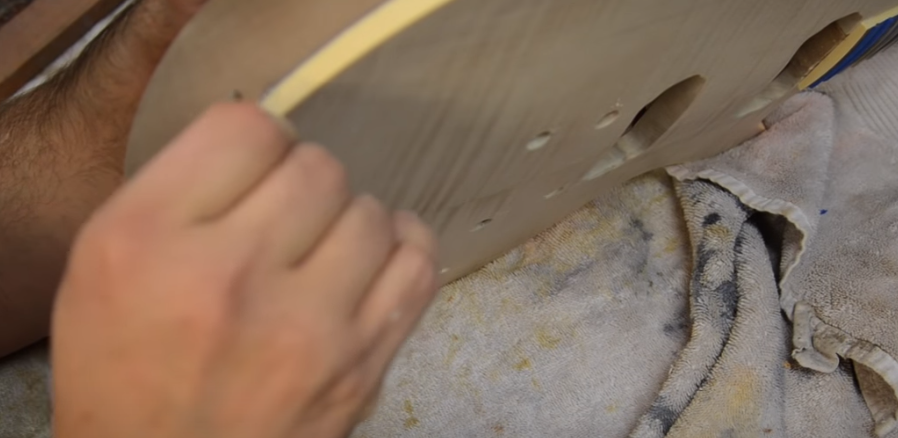
Note: this finishing kit does not include a final polish which is optional. In fact, even without it, you should already have obtained a very nice result. However, if you want more shine and an even smoother surface we invite you to undertake this final finishing step. Buffing can be divided into 3 steps, level sanding to remove the last defects, sanding for polishing and finally buffing. This will not be discussed further in this user guide.
TRU-OIL CONDITIONING
Now that the varnish has fully cured, the surface of the guitar may feel too glossy or slightly uneven. To achieve a professional, smooth, and natural finish, the next step is to refine and condition the surface.
A well-applied varnish protects your guitar, but achieving the perfect feel requires one last step. helps smooth the surface, soften excessive gloss, and enhance the final look.
Preparation
Using is a straightforward process, but patience and precision will yield the best results.
Before starting, ensure that:
- The varnish has dried for at least 24 to 48 hours (depending on humidity and temperature).
- The guitar is free from dust and fingerprints.
- ou have a soft, clean cloth (preferably microfiber or cotton) for application.
Application
- Shake the bottle well to evenly distribute the conditioning agents.
- Apply a small amount of conditioner to your cloth—do not apply directly to the guitar.
- Using light circular motions, gently rub the product onto the guitar's surface.
- Let the conditioner sit for about 5 minutes to allow absorption.
- Take a separate dry, clean cloth and buff the surface, using light pressure, until you achieve the desired sheen.
- If necessary, repeat the process for a smoother feel.
For best results, work in small sections and avoid excessive pressure. The goal is to subtly refine the finish, not remove the varnish layer.
Once complete, your guitar will have a smooth, refined finish that enhances both aesthetics and playability. The surface will feel more natural under your fingers while maintaining protection against wear and humidity.
POLISHING
General Information
Polishing is optional, and normally, even without it, you should already have achieved a very nice result. However, if you want more shine and an even smoother surface, we invite you to undertake this final finishing step. Polishing can be divided into three stages: leveling sanding to remove the last defects, sanding for polishing, and finally buffing. These steps will be further detailed below. Also, take note:
- Always be careful when sanding, applying very light pressure, especially near the edges. It is easy to remove varnish if you press too hard!
- Always ensure you remove all dust generated by your work environment or sanding. One idea is to run a fan simultaneously to remove dust immediately.
- From time to time, "tap" or rub your on a mat to remove embedded dust.
- For a water-based finish, do not sand with water. Use a dry sanding method. If you sand with water on a water-based varnish that has not completely dried, you may slightly remove your varnish layer.
- When using water, always use room temperature water. Cold water can damage and crack your finish.
Before starting, the wood should have already been sanded with P800 or P1000 grit in the previous step.
Preparation
Before you begin, make sure you have both dry and wet on hand in grits P1000, P1200, P1500, P2000, and P2500. For optimal results during sanding, we recommend placing your guitar on a soft, stable surface—like a carpet or thick towel—to protect the body from scratches and ensure even pressure as you work.
Processing
Leveling Sanding:This step is only necessary if you still have localized imperfections (such as drips or significant roughness). In this case, you should sand down to P400 to remove the imperfections, then progress to P600, P800, and P1000. For localized sanding, the sandpaper is smaller, and a smaller —is used, as it is a very localized sanding process.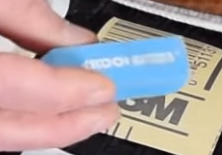
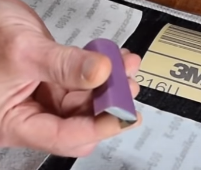
Tip: For sanding guitar edges and contours, flexible tools like a foam tip, rubber eraser, cork block, or even a thermal insulation sheath wrapped in sandpaper conform easily to curves, offering better control without flattening rounded areas. Mixing these lets you adapt quickly to different shapes while staying gentle on the wood.
Polishing Sanding:For the polishing step, refer to section IV. However, please note that this time, you should apply minimal pressure while sanding. The goal is to erode the surface, not remove material, but to eliminate slight surface imperfections created during the varnish application.
Start sanding with P1000 grit, then move to P1200, P1500, P2000, and finally P2500. Some prefer to continue, but you won’t notice a significant difference. Always remove dust using a running fan to prevent it from scratching your finish further!

At this stage, you should have a slightly whitened finish with micro-scratches removed. You can see this clearly by placing the wood near a light source and tilting it slightly to create reflections that make these scratches more visible. If you see micro-scratches, return to P1000 grit and work up to P2500.
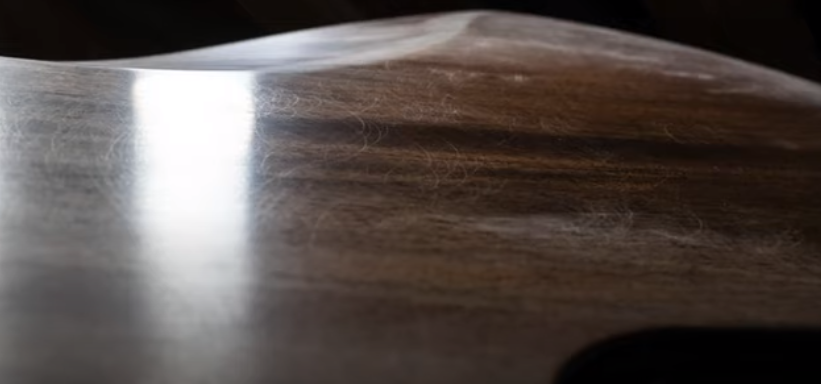
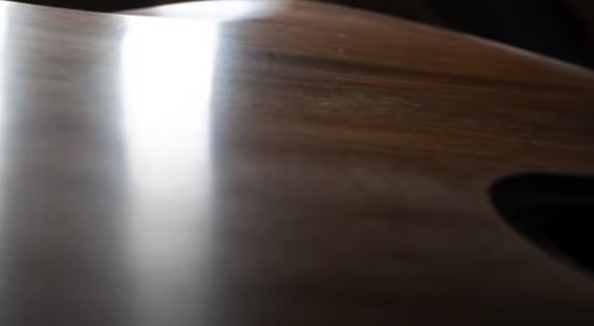
Before (left) & after (right) sanding
It is now necessary to buff your wood to transform the whitish surface into an ultra-glossy finish.
Buffing
This is the final step, where additional products must be applied. You can either use dish soap mixed with water or apply dedicated polishing products, such as those available on our website. In particular, our contains everything necessary for sanding, polishing, and hand buffing (a specific guide for polishing with this finishing kit is also included). Naturally, using products specifically designed for guitar buffing will provide much better results.
The selected polishing product can be applied either by hand or by machine.
By Hand: We recommend using microfiber cloths. Rub in circular motions, applying light pressure. Rinse and continue until you are satisfied with the result.
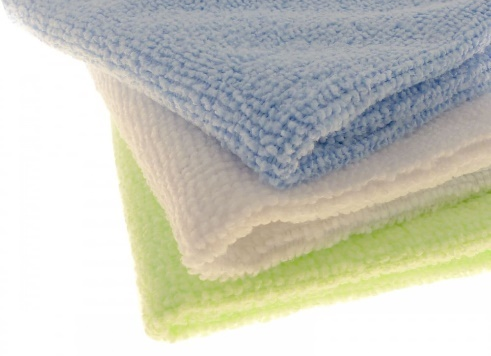
With a Machine: While dedicated polishing machines exist, you can easily use a drill with a polishing attachment to buff your guitar effectively. Always keep the drill moving at a moderate speed to avoid overheating the surface, as excess friction can damage the finish. Start with a firm for initial polishing, then switch to a softer to enhance the shine and achieve a smooth, glossy finish. Be aware that some areas may be too tight or curved for the machine to reach.
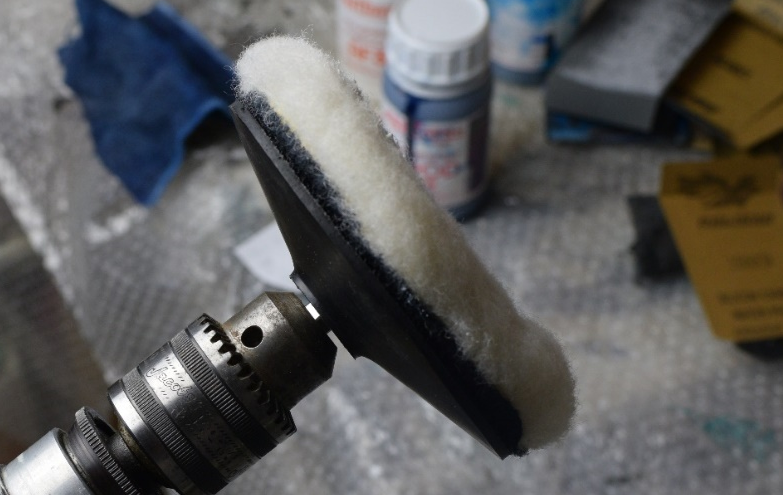
Note:
During this final buffing process, wearing a respirator and protective goggles is also advised, especially when using a polishing machine. Polishing product particles will be sprayed into the air.
Thank you for following our tutorial! Feel free to check our product:
Related Products
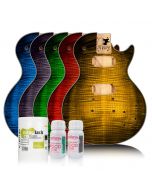
From $33.19 was $53.43
To $180.15 was $222.41
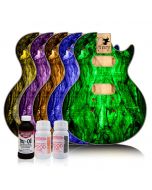
From $44.51 was $51.26
To $237.55 was $260.75
Related Posts
- The Guitar Fabrik
- Jun 27, 2025
- 234views
IBANEZ CUSTOM BASS SHOWCASE
- The Guitar Fabrik
- May 29, 2025
- 351views
B.C. RICH CUSTOM GUITAR SHOWCASE
- The Guitar Fabrik
- May 1, 2025
- 147views
MUSIC MAN CUSTOM BASS SHOWCASE
- The Guitar Fabrik
- Apr 28, 2025
- 594views
 UK
UK FR
FR DE
DE IT
IT ES
ES
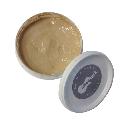
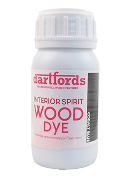 Black Dye
Black Dye